4 Days in Barcelona: Perfect Itinerary for First Timers
Wondering how to spend your time in Barcelona, and not sure where to start? You’re in the right place! We’ve been to Barcelona a couple of times over the past few years (including just under a week in the spring of 2024), and we’re here to do our best to help you plan an incredible trip.
Barcelona was the first stop on our first real foray into Spain, and we spent a full week in the city, exploring different neighborhoods, eating and drinking our way through the city, and walking A LOT.
After visiting other parts of Spain later on that trip, including Madrid and Andalusia, we came away with a new appreciation for Barcelona and its unique story and culture.
It’s a more international, cosmopolitan city (which has its pros and cons), and the history in Barcelona – and Catalonia more broadly – has a slightly different tinge to it than parts of Spain that are further south.
Barcelona has a lot of the things we look for in a city – it’s super walkable, full of great food and drinks, forward-thinking and diverse, and has some amazing history behind it.
However, those positives are certainly balanced by the sheer number of tourists that visit Barcelona. It’s extremely noticeable, especially in the narrow alleyways of the Gothic Quarter, where you’ll often run into tour groups of 50+ people trying to make their way through the oldest part of the city.
Over the course of your time in Barcelona, you’ll get a taste for what makes the city special (spoiler: it’s not Las Ramblas or the beach). Along the way, you’ll visit one of the most spectacular churches in Europe, learn how to cook a Spanish specialty, and connect with locals to get a fresh perspective on the city they call home.
In this guide, we’re going to give you a 4 day itinerary for Barcelona that is informed by our own experiences exploring the city over two different trips (one a few years ago, one more recently in the spring of 2024).
We’ll start with some logistics – like where to stay and how to get around – and then get into a specific itinerary for spending 4 days in Barcelona.
Our intention is to give you all the information you need to put together your own itinerary, and along the way help you discover a few places or experiences that we loved and think you will too.
Sound good to you? Let’s get into it!
P.S.: Planning a trip to Spain? We have a detailed Spain itinerary plus guides to Madrid, Granada, and Seville to help you plan an amazing trip!
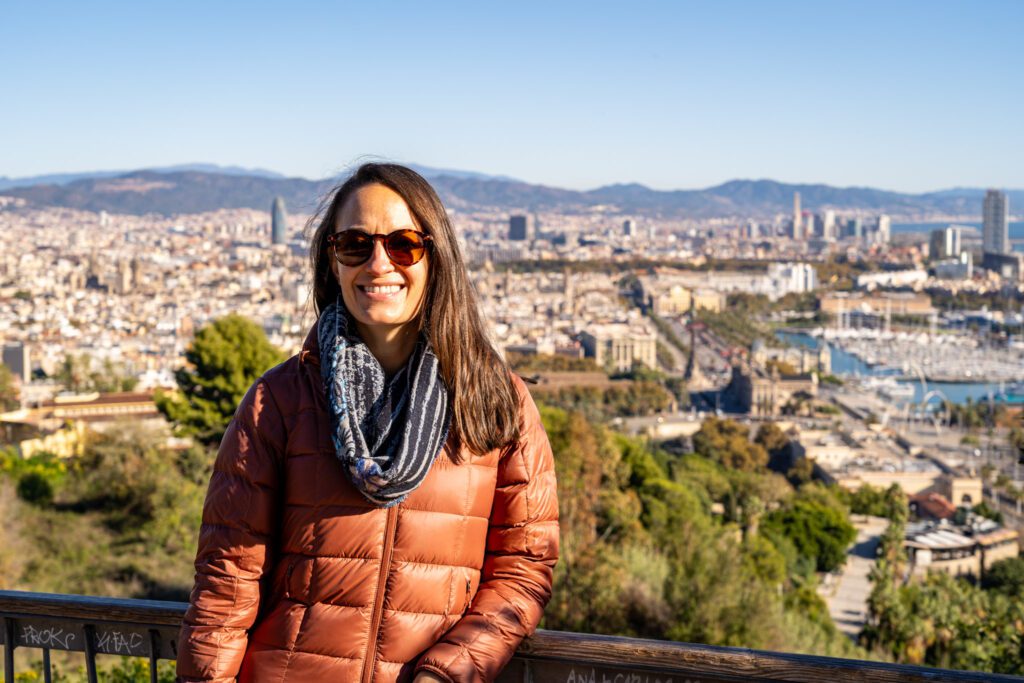
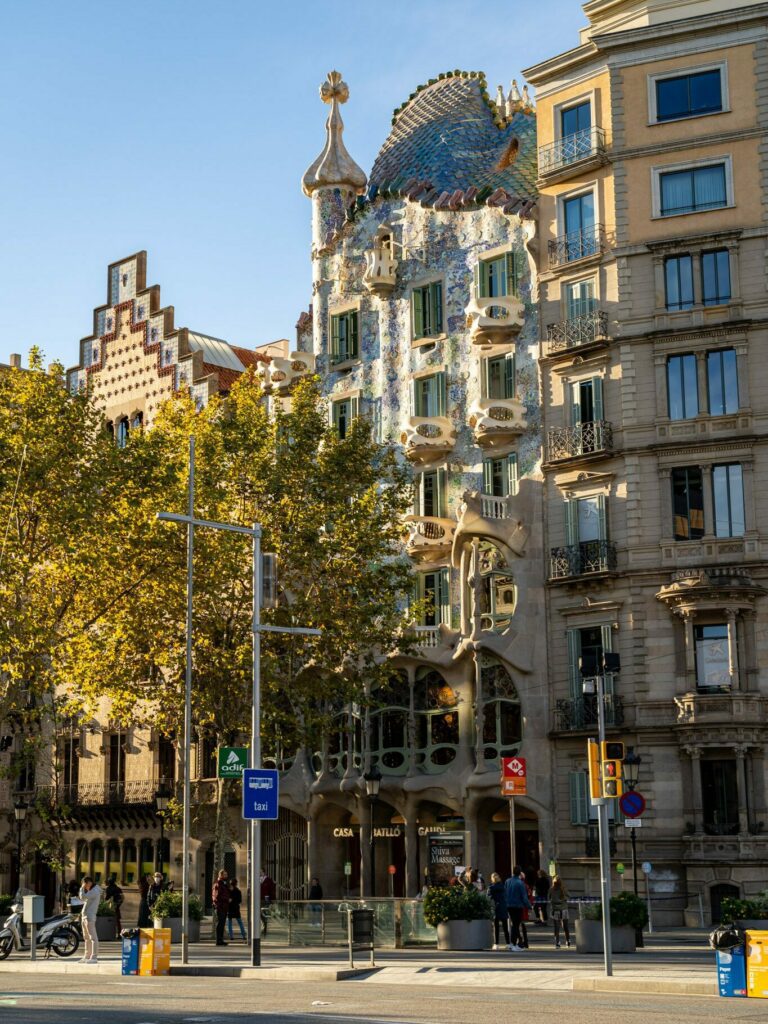
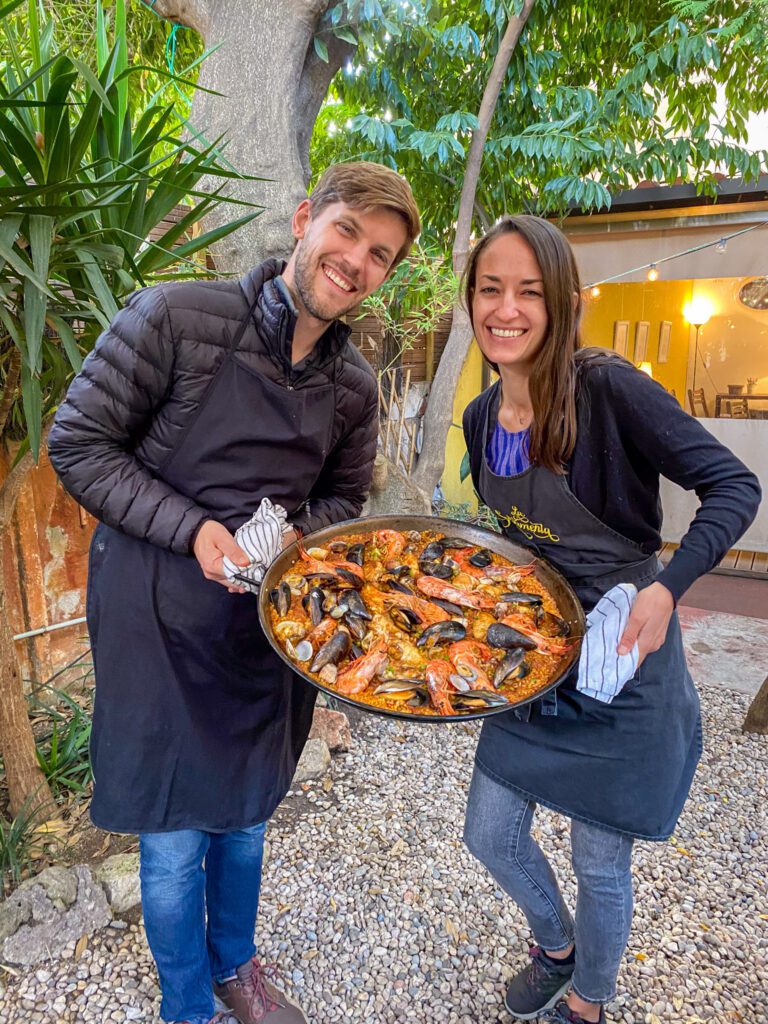
Disclaimer: Some of the links in this post, like hotel links, are affiliate links, meaning at no additional cost to you, we make a little bit of money if you click through and book. That being said, we would never recommend something to you that we don’t stand behind 100%.
How Many Days to Spend in Barcelona
Barcelona is a huge, fascinating city, but it’s not exactly filled with landmark tourist attractions like Paris or Rome. It’s much more similar to a city like Lisbon in that it has a few major tourist attractions, but the best part about it is exploring different neighborhoods and, of course, eating and drinking.
All that being said, we think you need at least 3 days in Barcelona itself, plus a day for one of the awesome day trips available that take you deeper into Catalonia and the distinct culture that has thrived here for thousands of years.
In other words, we think four days is the right amount of time to experience Barcelona without feeling too rushed, and to fit in that day trip.
It’s also not too much time in Barcelona – you’re going to find your days are still full, and you’re going to leave with a list of things you want to do next time you’re in the capital of Catalonia.
If you have more time or less time to spend in Barcelona, don’t worry – we have an entire section for you below the main itinerary with how we’d recommend spending one, two, three, and five or more days in Barcelona.
However much time you have in Barcelona, you’ll be able to use this detailed guide to planning your Barcelona itinerary to organize your trip, figure out the best things to do and see, and plan an incredible trip.
Where to Stay in Barcelona
We think there are a bunch of possible answers to the question “where should I stay in Barcelona?” The truth is, it depends on what you’re looking for.
Which is why we’ve written an entire guide to the best places to stay in Barcelona, with a detailed breakdown of strengths and weaknesses of each neighborhood.
However, you’re here for the short version, so here it goes.
Here are the two neighborhoods – that we’ve stayed in – that we would absolutely recommend (especially for a relatively longer trip of four or more days) as nice home bases for exploring Barcelona.
PS: Whatever you do, DO NOT STAY ON LAS RAMBLAS (or within a few blocks of it). It’s a giant tourist trap, and you will end up paying more than your room is worth for the privilege of it being super loud all day and night.
Gràcia: The Coolest Part of Barcelona
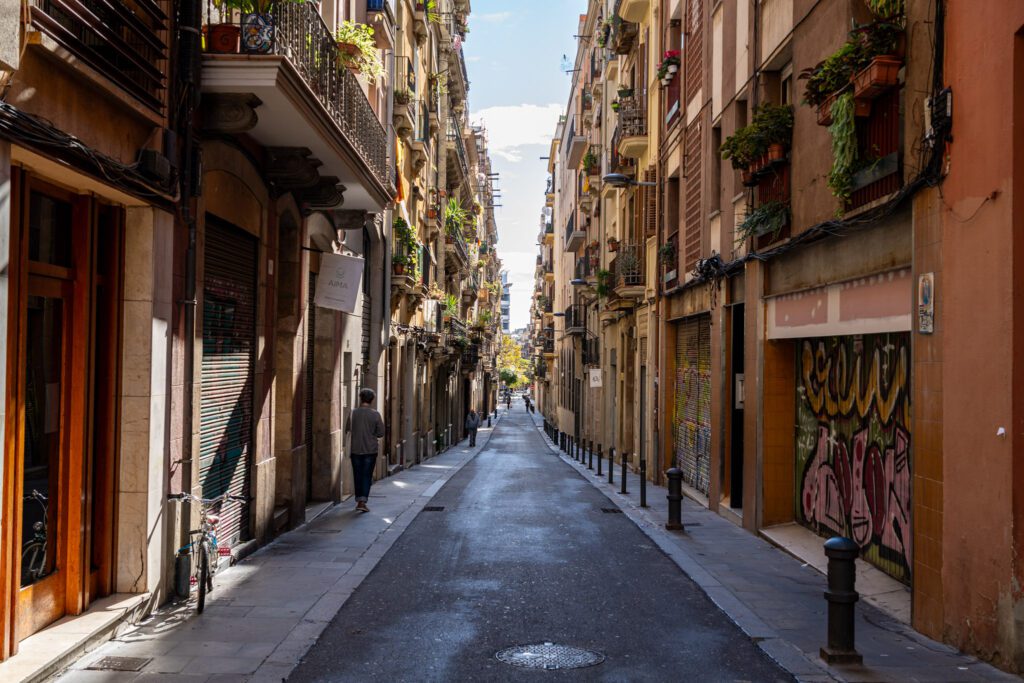
This is the part of the city that we fell in love with, and we stayed here for the first half of our first trip to Barcelona (together – we had both been separately before).
It used to be its own city before the expansion of Barcelona swallowed it up, and still retains some of the distinctly independent vibes that it once had.
It’s less central (and further from the cruise ship terminal) – and therefore, less full of tourists at all hours – than most of the more central neighborhoods.
But it’s still really, really well connected to the rest of the city via the metro (two lines run through this area), and we had no problem getting from place to place while we were staying in Gràcia.
We stayed at Casa Gràcia, which we had a love-hate relationship with.
The idea – a hostel with private rooms, dorms, and apartments and plenty of common spaces – is great! However, the rooms were deeply in need of an update (and a deep clean). We were disappointed because it has so much potential!
If you’re looking for an affordable place to stay in Gràcia with a similar vibe but better facilities, look at Casa Jam Barcelona.
Here are some places to stay in Gràcia that caught our eye, and that we think you will like.
- If you want a boutique hotel: Seventy Barcelona
- If you want a great value hotel: Casa Mathilda
- If you want to stay in an apartment: Be Mate Paseo de Gràcia
- If you want a hostel (with a private room): Yeah Barcelona Hostel or Casa Jam Barcelona
L’Eixample: Central and Well Connected
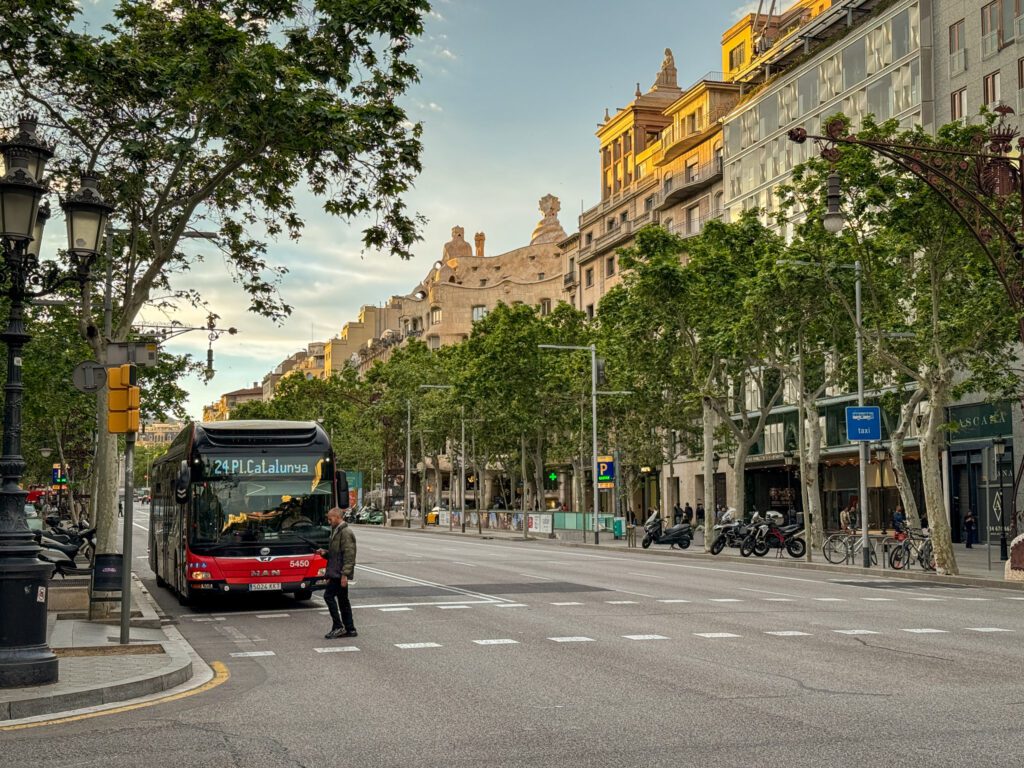
Matt spent the entirety of his latest trip to Barcelona in this central neighborhood, which is significantly more modern than the Ciutat Vella because of the fact that it was built well after the old town as a way to connect ever-expanding Barcelona with the smaller towns (like Gràcia) outside the old city walls.
The name literally means “the expansion” because that’s exactly why it was built.
It’s more of a grid, with wide boulevards and a distinctly Parisian feeling to it (I’m sure Barcelonians love hearing that), which is a stark contrast to the old, windy alleys of the Gothic Quarter and El Born.
Still, it’s a nice place to stay precisely because it’s so central, and it has some things to do and see that make it a place to visit in its own right, like Passieg de Gràcia and some excellent food and drink spots nearby.
Overall, I think this is probably the most practical place to stay for a shorter trip (3-4 days) because it gets you out of the mayhem of the Gothic Quarter, but still within an easy walk or metro ride to those places.
Here are some places to stay in l’Eixample that caught our eye (three of which we’ve actually personally stayed at, and you can see a few pictures below), and that we think you will like.
- If you want a boutique hotel: Casa Bonay (where Matt stayed)
- If you want a great value hotel: Praktik Essens (where Matt stayed)
- If you want to stay in an apartment: Apartments Sixtyfour (right on Paseo de Gràcia – the part that’s in l’Eixample)
- If you want a hostel (with a private room): TOC Hostel (where we stayed)
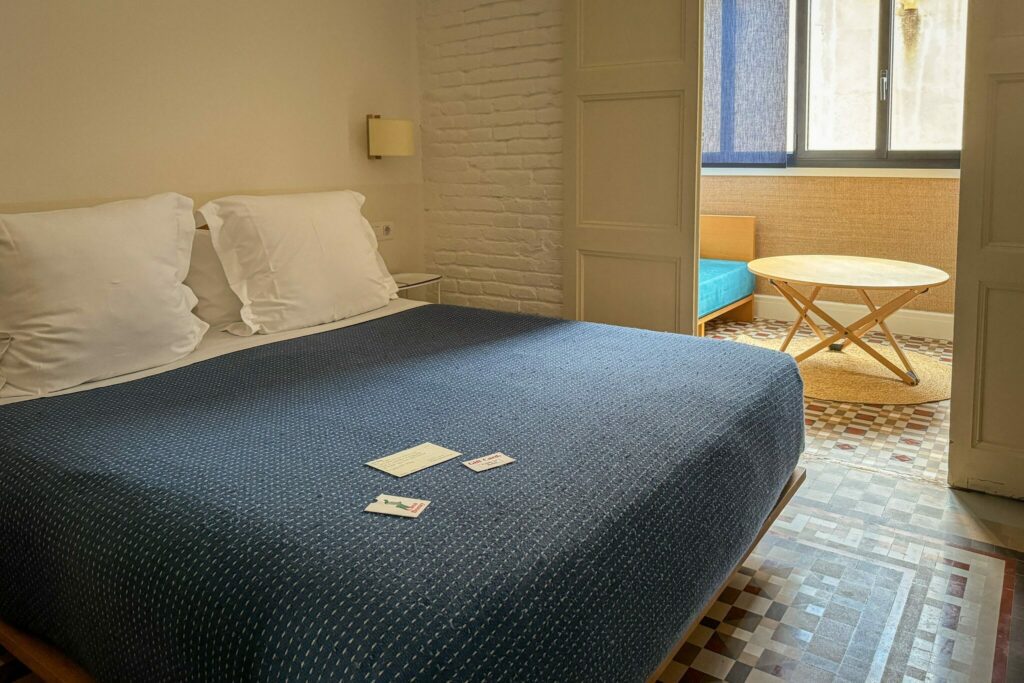
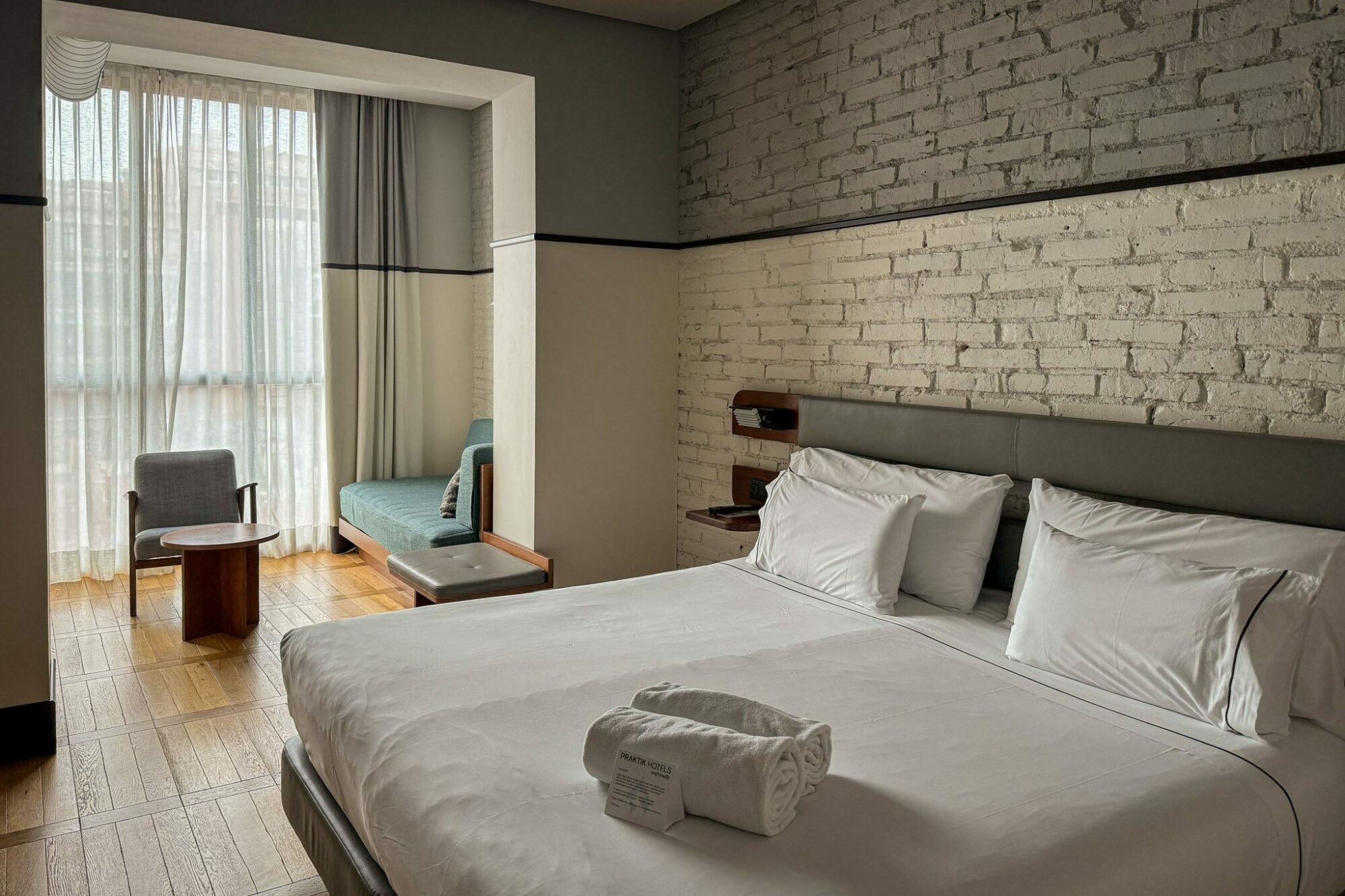
4 Days in Barcelona: How to Plan a Perfect Barcelona Itinerary
Now that we’ve covered some basics, let’s get into exactly how to spend your time in Barcelona.
The first thing you should know going into this particular itinerary is that it’s focused much more on experiences than checking off every single tourist attraction in Barcelona.
Sure, there are a bunch of Gaudí sites to see in Barcelona, but with just four days, do you really need to see them all? Probably not.
Instead, focus on one or two that are worthwhile, and save the rest for next time.
The same goes for both churches and markets, both of which there are plenty of in Barcelona.
To illustrate the point above, there are two Gaudí sites in Barcelona that you’ll find on every other itinerary, but we purposely excluded because it’s just too much!
Those two are Casa Milà and Casa Batlló, which are in the “with more time” section below, but not in the main itinerary.
Instead, we’ve included a lesser-known (but equally interesting) site – Casa Vicens – which was Gaudí’s first foray into residential architecture, and is slightly off the beaten path (as much as anything can be in Barcelona) and doesn’t have lines around the block in front at all hours of the day.
We have a secret for you. And it’s a lesson that it took us years of traveling to finally learn on our three month European extravaganza a few years ago.
Travel is better – and by better, we mean more rewarding, interesting, and fun – when you try your best to connect with locals to see the place through their eyes.
We took that to heart in Spain, and have done a bunch of different tours and experiences over the past few visits that have opened our eyes to a new side of Barcelona, its unique culture, and its people.
Our biggest tip for Barcelona is to prioritize tours (which is what you’re going to see in this itinerary).
In terms of structure, we always do our best to anchor the days in our itineraries around a main experience, with time on either side for things like coffee, cocktails, and good old fashioned wandering around a neighborhood.
And we never, ever do multiple museums (or major sights) in a single day. Trust us and learn from our mistakes – you WILL be exhausted by the time you get to the second one, and will get a lot less out of it.
In general, the itinerary that you’ll find below is structured with one major sight per day – like the Sagrada Familia, for example – with time for exploring a particular neighborhood and eating and drinking your way through the city on either side of that main attraction.
Here’s an overview of the itinerary you’ll find below:
Here’s a high-level overview of the day-by-day itinerary you’re about to read.
- Day 1: Exploring the Gothic Quarter & A Walking Tour
- Day 2: La Sagrada Familia & Barceloneta
- Day 3: Choose Your Own Day Trip Adventure
- Day 4: Casa Vicens, Park Güell & Learning to Make Paella
We don’t want to be too prescriptive – obviously, you could do a day trip on the fourth day in Barcelona instead of the third if it works better for your particular schedule.
Day 1: Exploring the Gothic Quarter & A Walking Tour
On your first morning, it makes sense to spend your time exploring the Gothic Quarter, home of the original city of Barcino that was founded by the Romans 2,000 years ago, before taking a walking tour with a local guide to get your bearings in the city and learn a few things along the way.
Finish with a guided tapas tour where you’ll not only try some delicious food, but also get the context behind it, which we always find fascinating.
The Gothic Quarter: La Boqueria and Las Ramblas
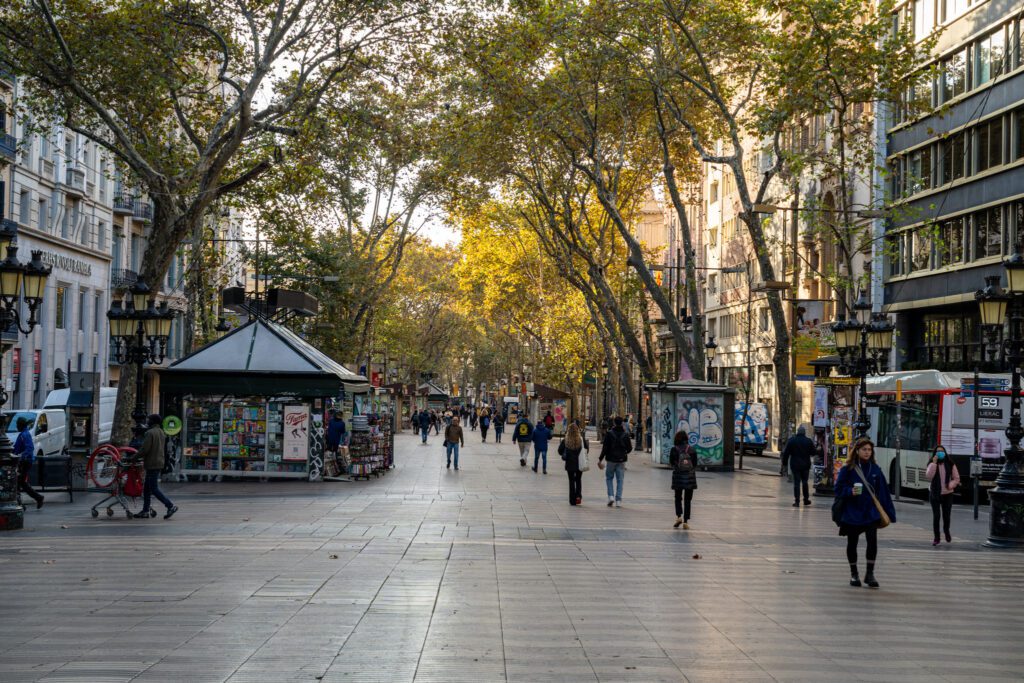
Start your morning out in the Gothic Quarter, the oldest part of the city and the place where the original city of Barcino was founded by the Romans two millennia ago as a trading post on the Iberian Peninsula.
Despite being the main tourist attraction in Barcelona, there is still something romantic about the dark, narrow alleys of the Gothic Quarter, which make the huge city of Barcelona feel small and quiet in the way that they insulate you from everything going on outside that particular street.
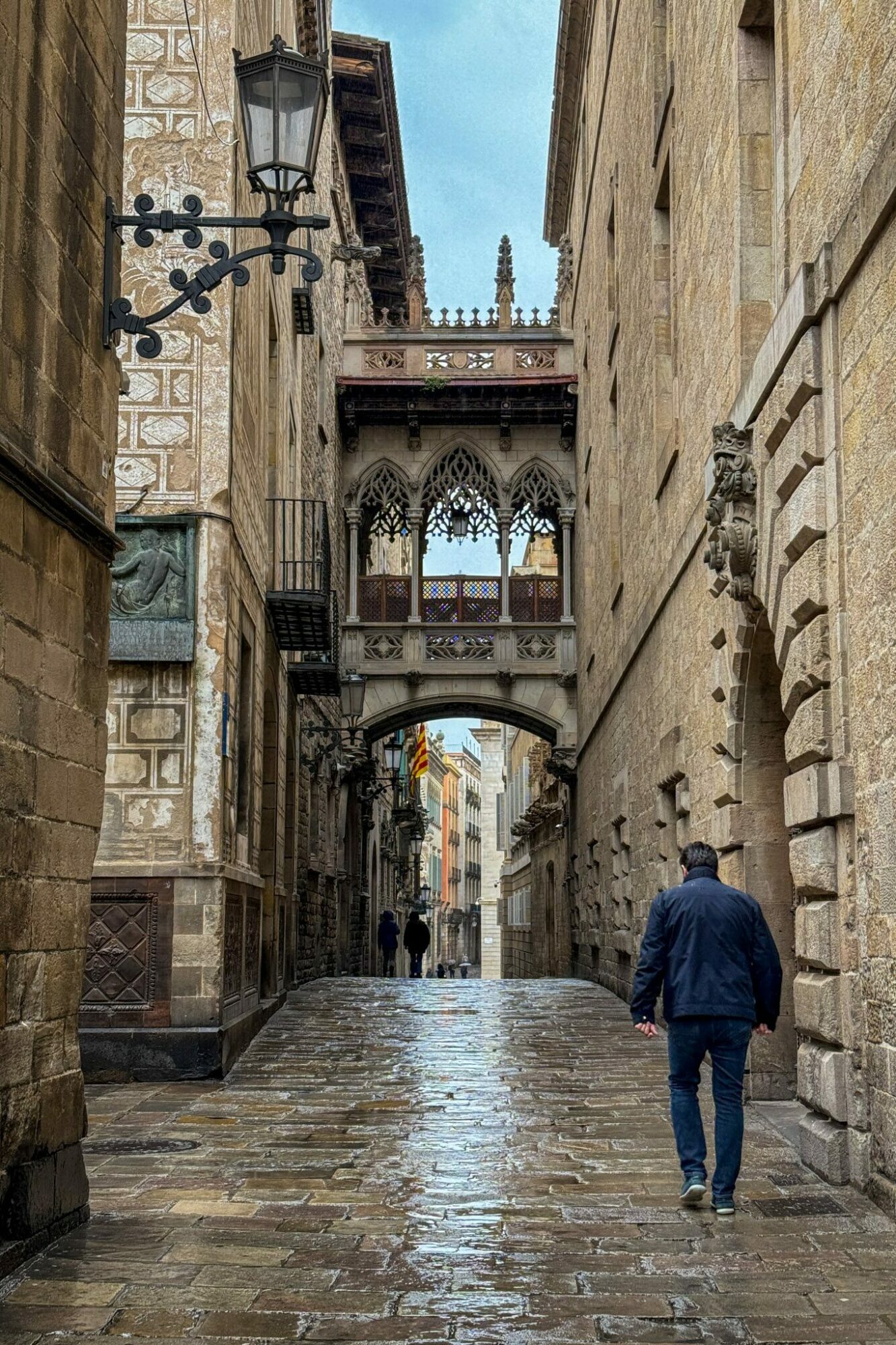
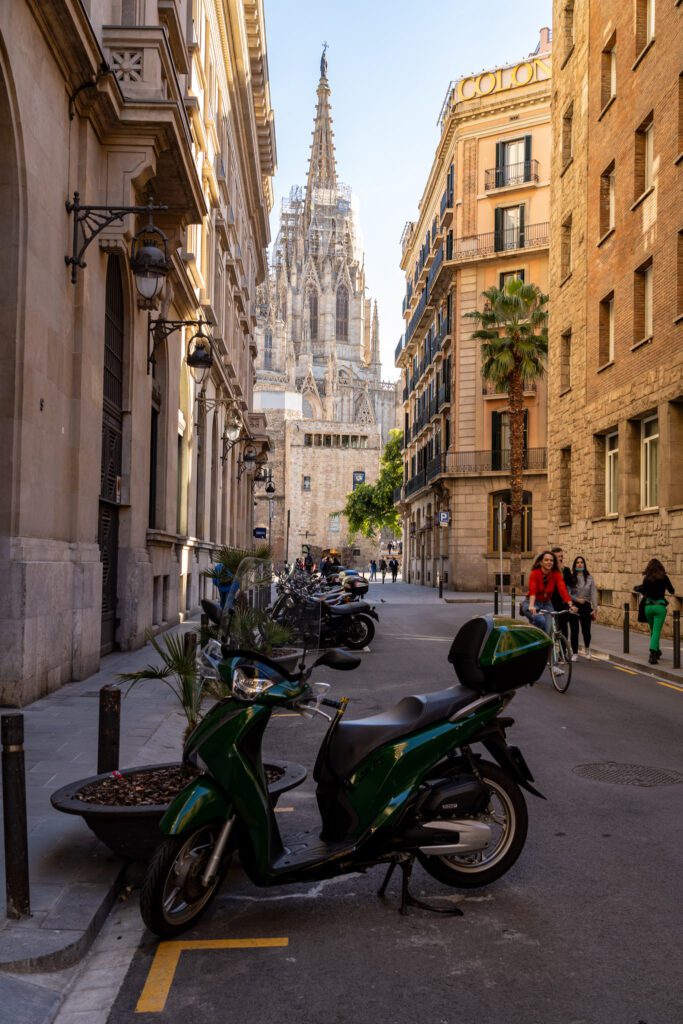
Today, it’s the most-visited part of the city, and Las Ramblas – the famous thoroughfare running from Plaça de Catalunya down to the water – is bustling, loud, and wild at almost all hours of the day (though, not in the early morning!).
Theoretically, it’s lovely with its tree-lined pedestrian lined with flower vendors, but in reality it’s pretty unbearable at most hours.
Start your day off right – with some great coffee at Right Side Coffee Bar, which is just a few blocks off of Las Ramblas.
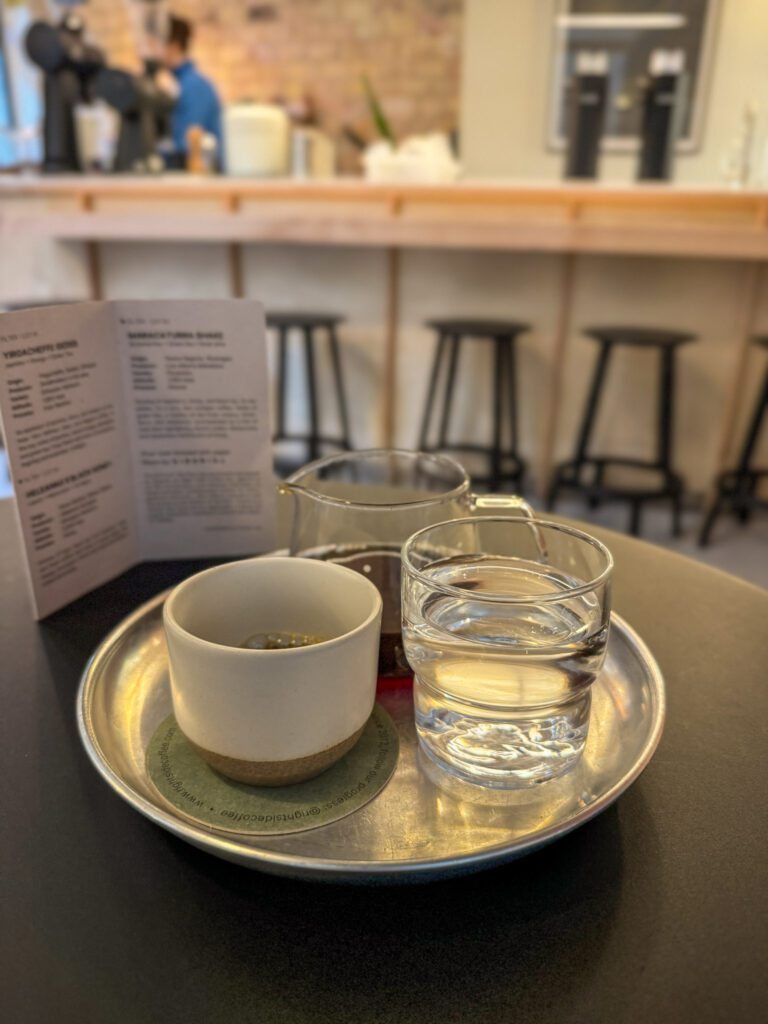
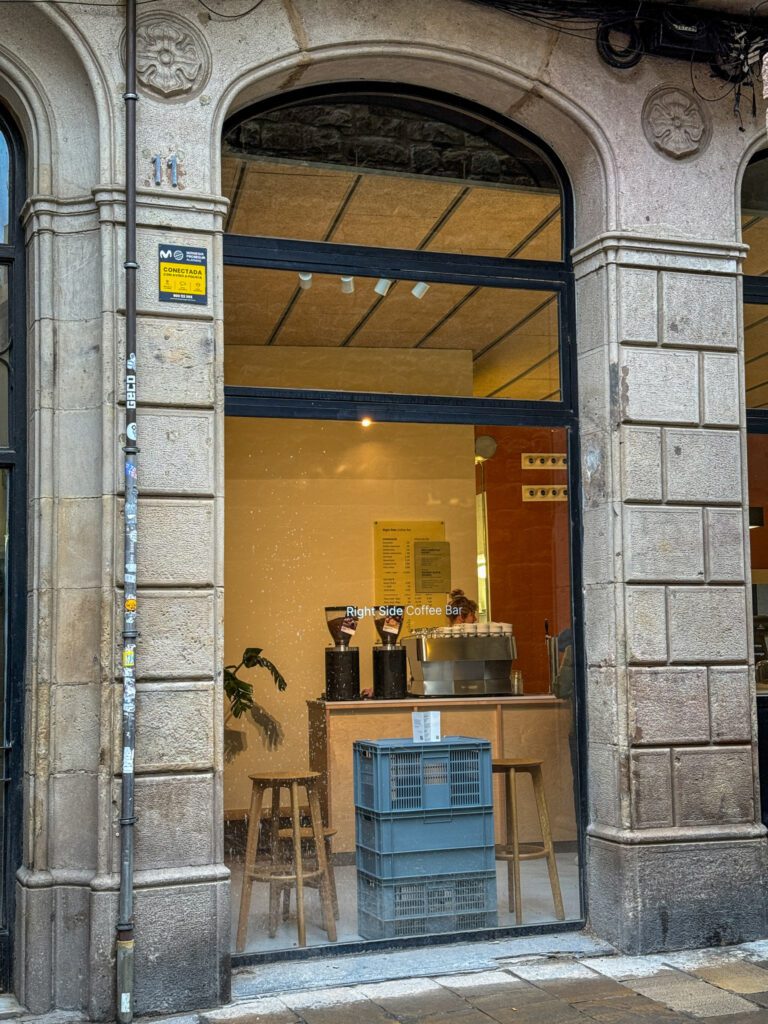
Take the metro (or walk) to Plaça de Catalunya and wander south before veering off to the left to head to get some coffee. Right Side is one of the original specialty coffee roasters in the city, and they have a nice space with high ceilings and a range of coffee drinks from filter to espresso and milk drinks.
After you’re caffeinated, head back out to Las Ramblas and make your way to Mercado de La Boqueria, the most famous (and, therefore, most visited) of Barcelona’s markets.
It is packed with tourists, yes, but we think it’s still well worth visiting, especially early in the morning before it’s wall-to-wall with people oooohing and aaahhing over the fresh produce, cured meats, and fish (among many, many other things).
It’s a great place to pick up souvenirs, snacks for later (like meat and cheese), or fresh fruit and juice for breakfast, which is what we opted for.
Get a container of sliced mango and some fresh papaya juice and take some time to wander the hundreds of stalls.
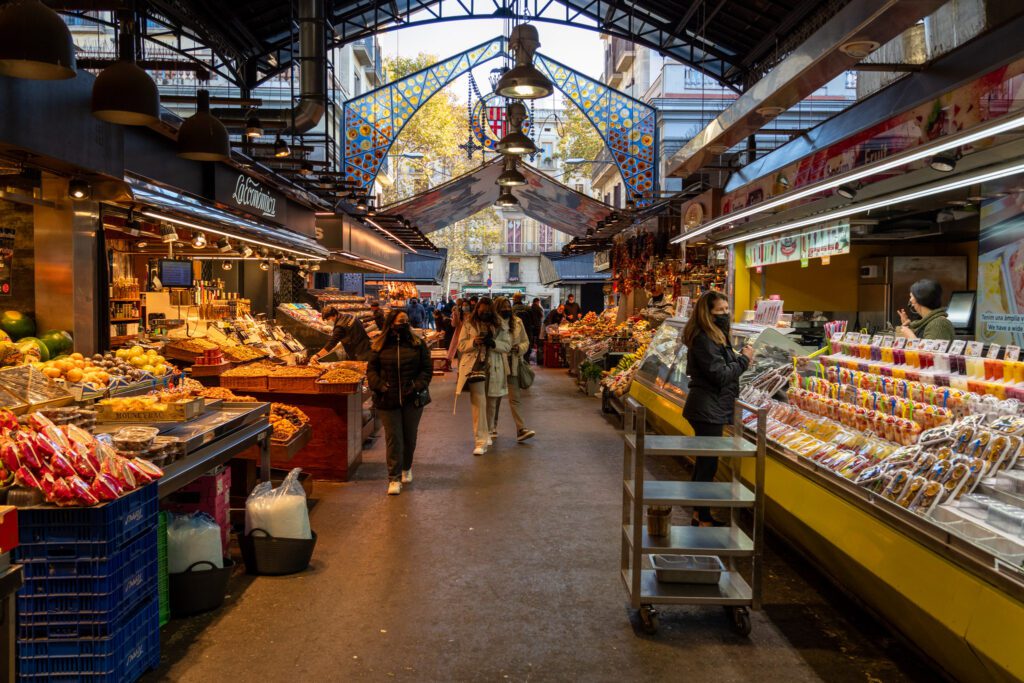
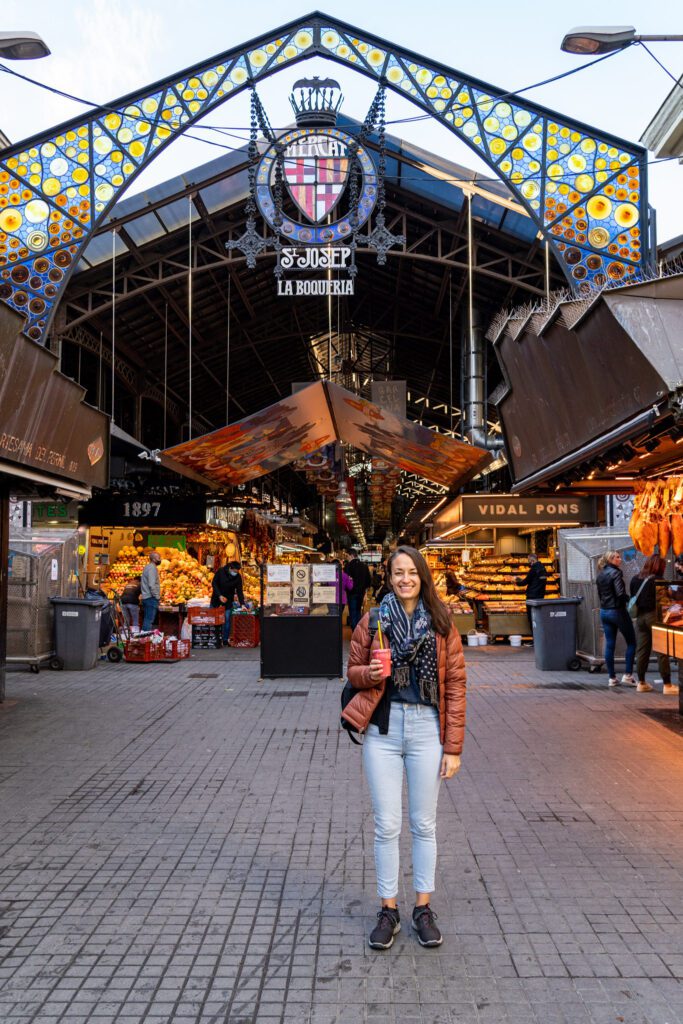
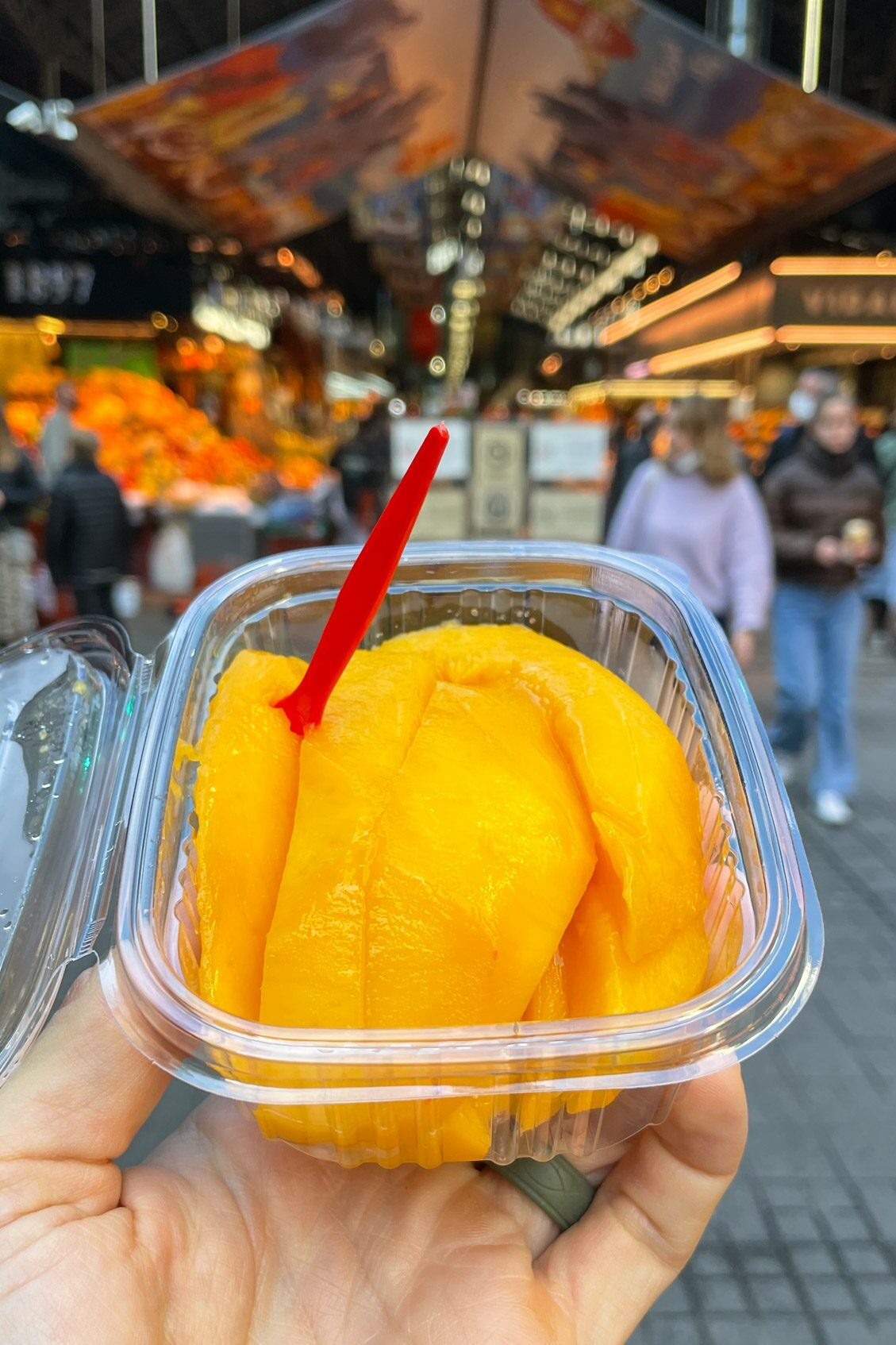
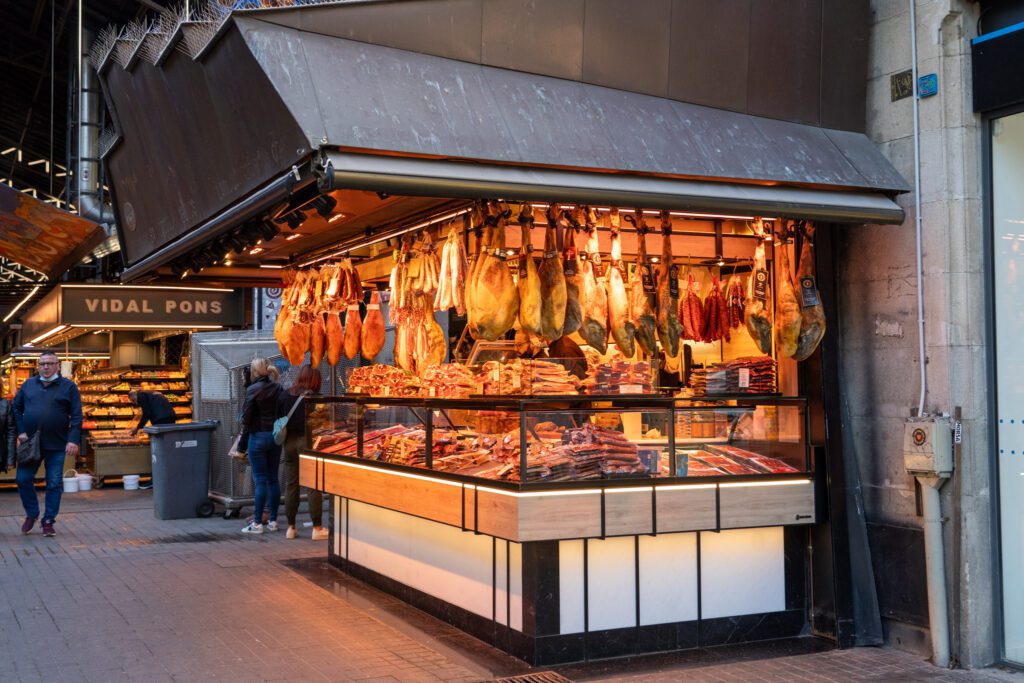
Continue all the way down Las Ramblas – 1.2 km or so – to the Christopher Columbus Statue (who is somehow revered for making a huge mistake for thinking that the Americas were India, among other things) that marks the end of the street. Congratulations, you walked Las Ramblas from start to finish.
Now, we’d recommend spending the entirety of the rest of your time away from Las Ramblas exploring Barcelona a little more deeply, only returning to cross the main thoroughfare en route to a different spot.
An Introductory Walking Tour
We always like to do a walking tour on our first day in a new city for a couple of reasons.
Over the past few years, we’ve come to the realization that walking tours are often our favorite way to get oriented in a new city for a few reasons.
First, you get a crash course in history and culture, which is a valuable baseline that will make the rest of your trip more enjoyable.
Second, you get to spend a few hours with a local who will give you all sorts of tips about what to eat, drink (and see), and specifically where to find the best version of said things.
Last, but not least you’ll discover places that you definitely would never have found on your own.
All this is to say that if you want to get below the surface of the historic center of Barcelona, you should absolutely do a guided walking tour.
We avoid the free tours now because we’ve found that the guides are just never as good as the ones you pay for… which makes total sense. It’s worth the slight investment on our part to have a local expert giving us the real deal, rather than a college student who memorized a script, often isn’t a local, and is working for tips.
We did this walking tour, and our guide Miguel gave us a fantastic introduction to the city of Barcelona.
It was funny, engaging, disgusting at times, and overall a really fun way to get oriented in a new city.
Another option is this Highlights and Hidden Gems tour with With Locals, a tour company that I also really like that focuses on private tours that are completely customizable.
We’ve done tours with them all over Europe, and I actually did that tour (solo) in Barcelona. It probably starts to make sense from a price perspective if you have more than two people.
An Evening Tapas and History Tour
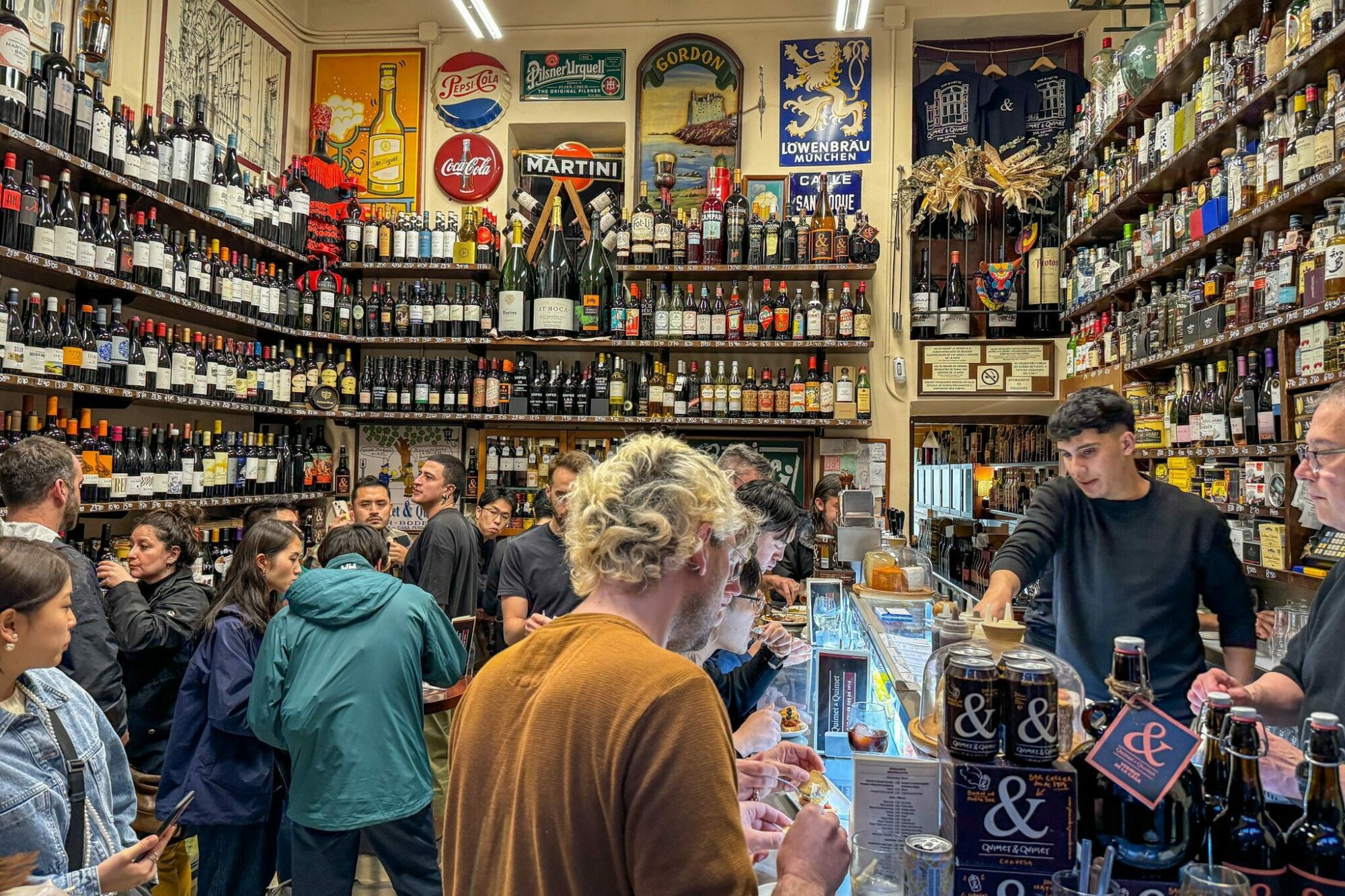
Round out your first day in Barcelona with an evening tapas tour with Devour Food Tours, one of the OG food tour companies in Spain.
It was founded in 2012 to help support struggling local restaurants during the recession, and has become a Europe-wide food tour empire since.
Their tours, unfortunately, are not safe for people with Celiac Disease (that’s me!), otherwise we would have done one ourselves. But that doesn’t mean you can’t!
However, I did get to go out to a couple of tapas bars with some friends in Barcelona (I didn’t get to eat anything), and it was one of my favorite experiences on that second trip.
The tours may seem expensive, but you’re basically getting a history tour and food tour all in one.
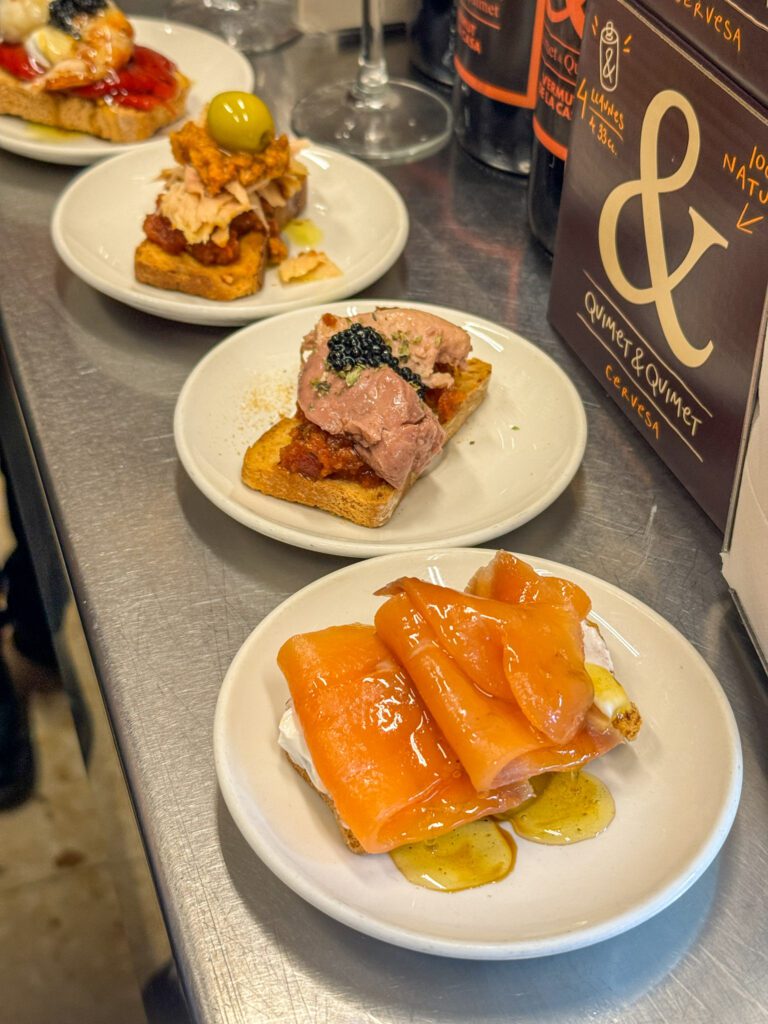
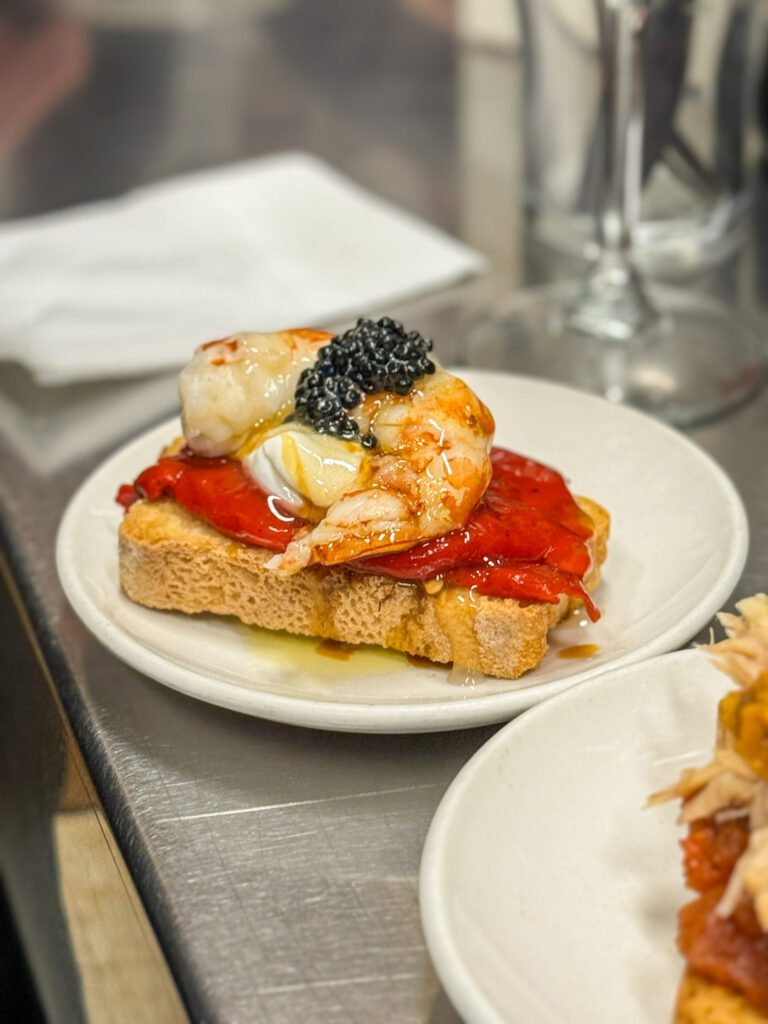
Come hungry, because you make a bunch of stops along the way at some of the most historic establishments in the city, and your local guide will tell you rich stories that will help you contextualize what you’re eating and get a couple of levels deeper than “wow, these patatas bravas are tasty.”
It’s a three and a half hour tour, and it includes the equivalent of a full dinner plus drinks.
Click here to check prices, reviews, and availability.
Day 2: La Sagrada Familia & Barceloneta
On day two, spend your morning at La Sagrada Familia, the most impressive church in the world (in our opinion, anyway), then spend the afternoon in Barceloneta.
Coffee near La Sagrada Familia
Before you head into the Sagrada Familia, you’re going to want to be caffeinated. And there are not one but TWO excellent coffee shops within a few blocks of the basilica to get your daily caffeine dose.
The first is about half a block up the street, and it’s called Café Fargo. They have multiple roasters – usually Nomad, who is from Barcelona, and a couple of other European roasters that rotate every few weeks.
I had coffee here one sunny morning, and it’s a cozy little spot with a very friendly owner (and other baristas) who brew a good cup of coffee.
The other option is on the other side of the basilica, and it’s called Blackbird Coffee Corner. It’s a tiny little shop on a corner with a couple of outdoor tables (and no indoor seating) that serves Nomad Coffee (my favorite coffee roaster in Barcelona) and has a nice selection of pastries that you can grab as a snack before your visit to the basilica.

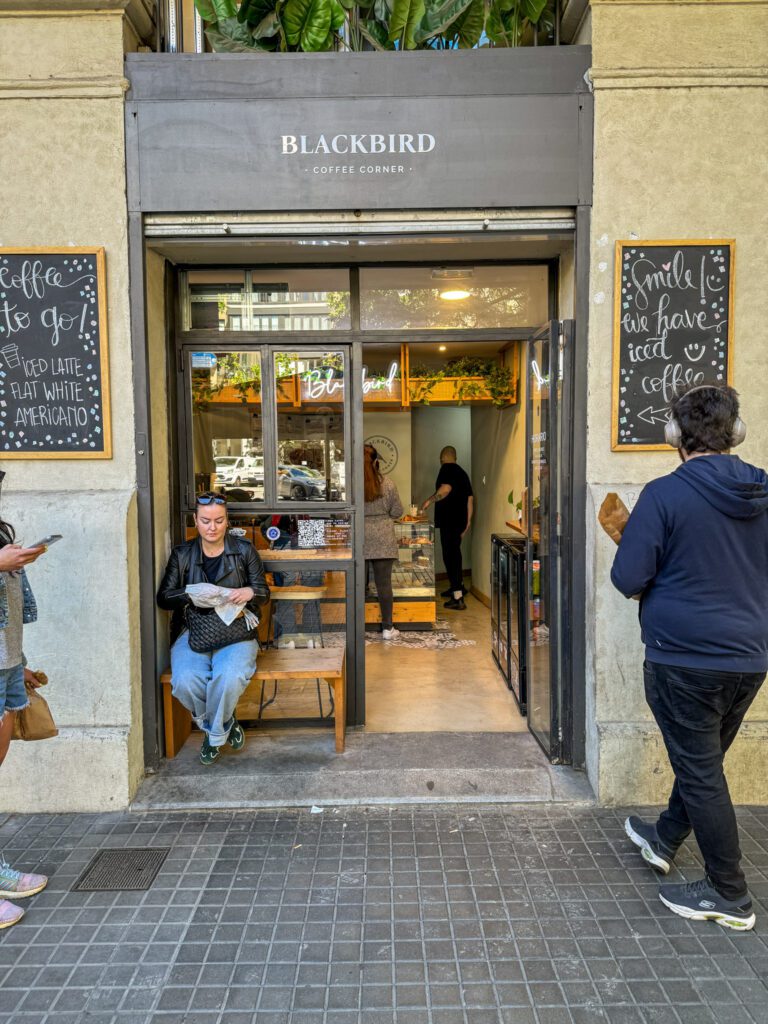
Marvel at the Beauty of La Sagrada Familia
Look, we spent three full months in Europe, exploring Portugal and Italy over two months before arriving for just over a month in Spain and let me tell you, we saw a lot of churches.
La Sagrada Familia is easily the most impressive, and it’s because of the details. It is abundantly clear how much thought and care was given to every single last detail of this architectural marvel.
However, it’s worth noting that it is a basilica (a church that has been consecrated by the Pope, but is not the seat of a bishop or archbishop), NOT a cathedral (that seat lives at the Barcelona Cathedral at the time of writing).
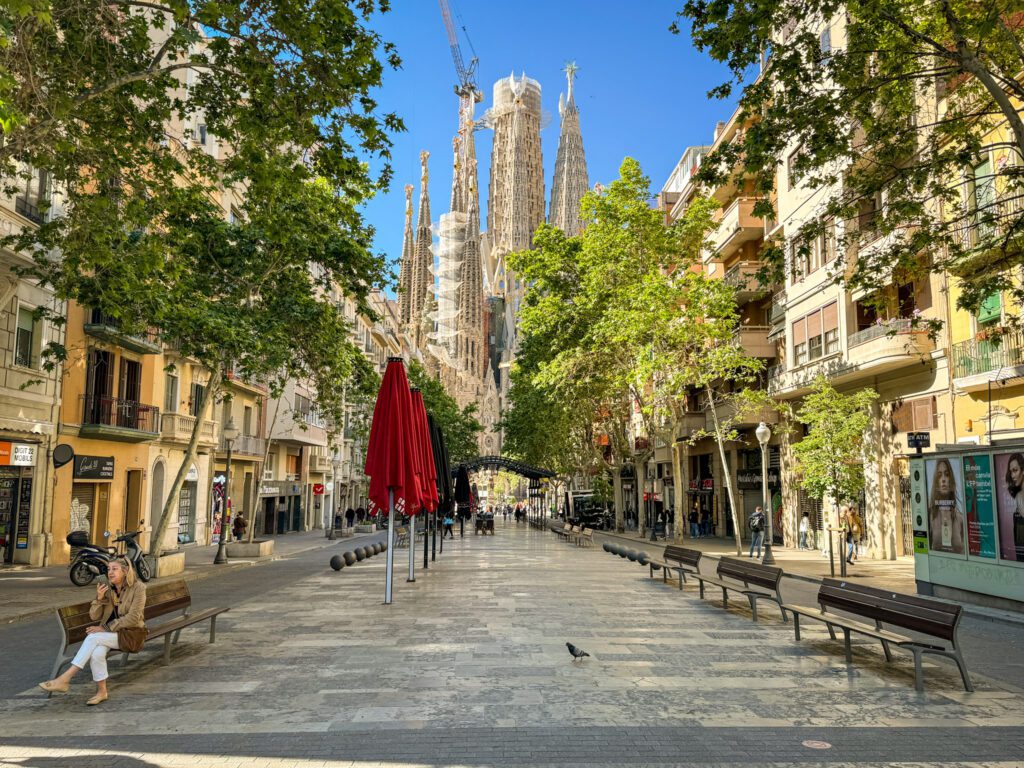
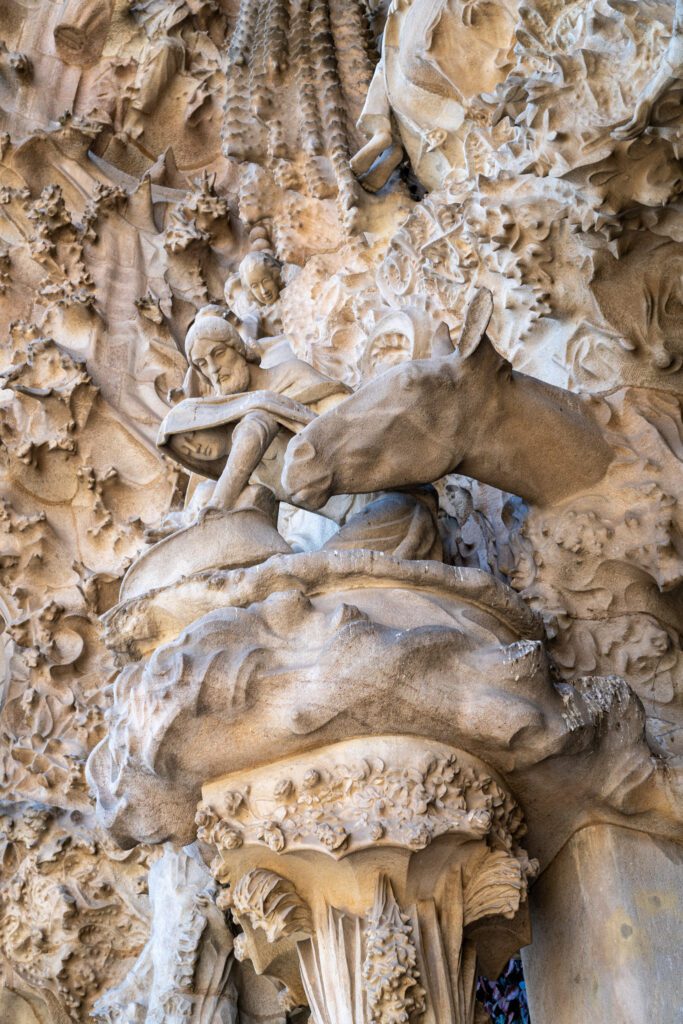
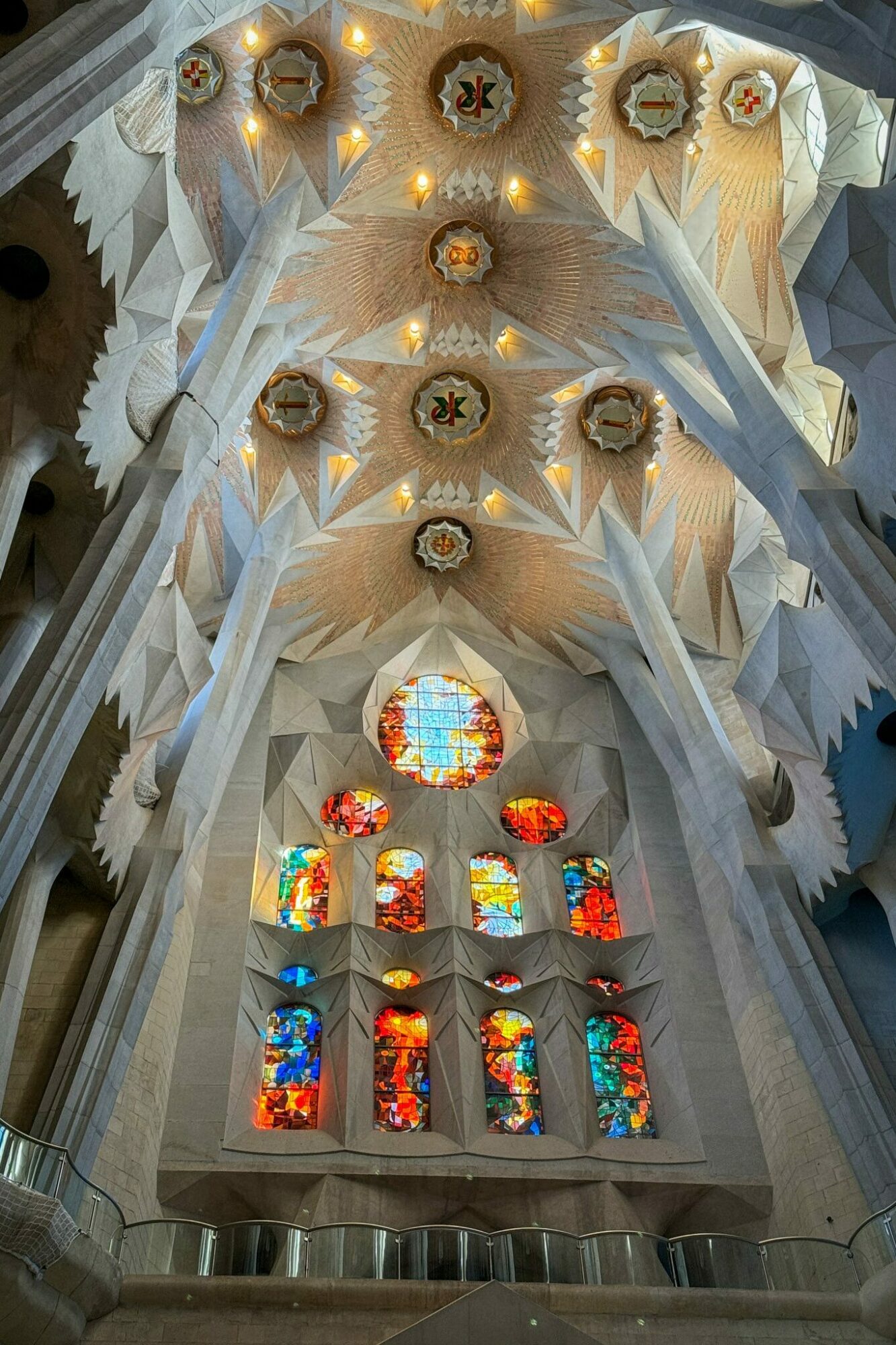
The contrast between the two facades – which you’ll learn about in the handy audioguide (more on that in a second) is fascinating, as is the entire structure. They feature stories of Jesus’ life, death, and resurrection.
My favorite aspect is the fact that it’s oriented so that the sun rises on the “life” facade, which has stained glass windows of blues and greens, and sets on the “death” facade, which is all oranges and reds.
The brain that came up with all these details that ladder up to the bigger picture is something that my brain can’t even comprehend.
While there are bigger churches and more ornate churches out there, this is the pinnacle for us.
It’s still under construction after being started in 1882 (Gaudí actually didn’t join the project until a year later, in 1883 though, which I didn’t know).
Gaudí died in 1926, but left a detailed plan and sketch of his vision for future architects to bring to life. However, there was a slight hiccup in the 1930’s when, during the Spanish Civil War, people broke into the crypt and destroyed his plans, which took more than 10 years to rebuild.
Hence, the Sagrada Familia is still under construction, due to be completed in 2026, the 100 year anniversary of Gaudí’s death as of my most recent trip, the date had been pushed back to after 2030 sometime.
However, one of our guides in Barcelona mentioned that he’d expect even that later date to be delayed.
We’d highly recommend going either early in the morning or late in the afternoon, when the light streams through the amazing stained glass windows and creates a pretty marvelous light show inside the basilica.
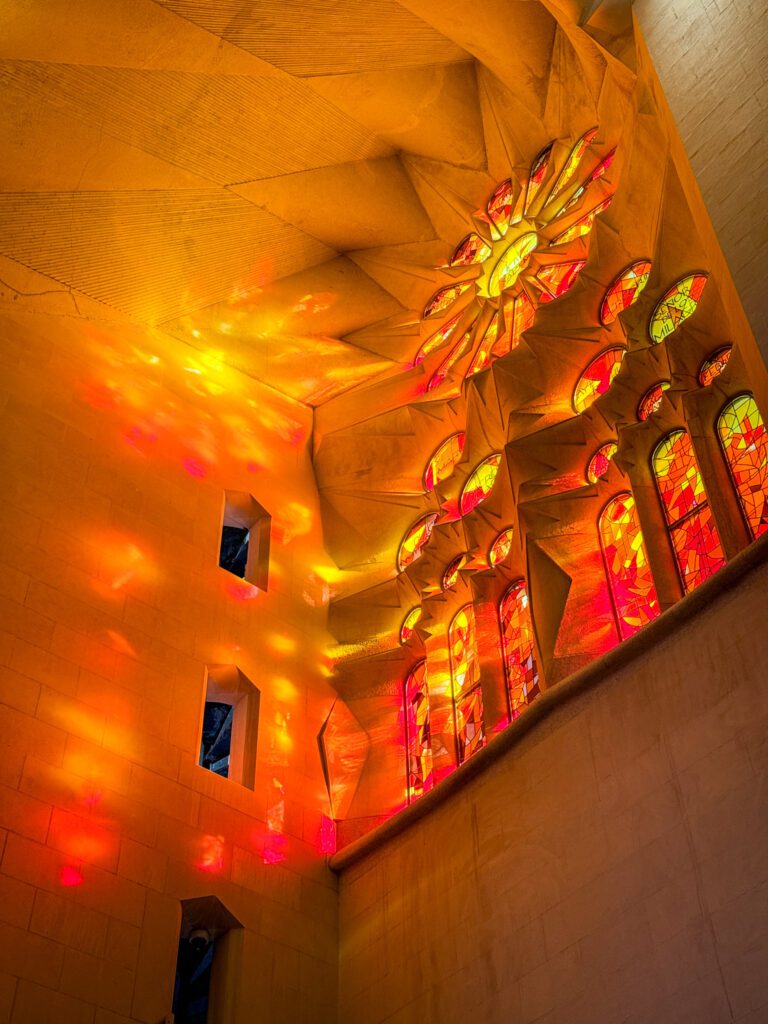
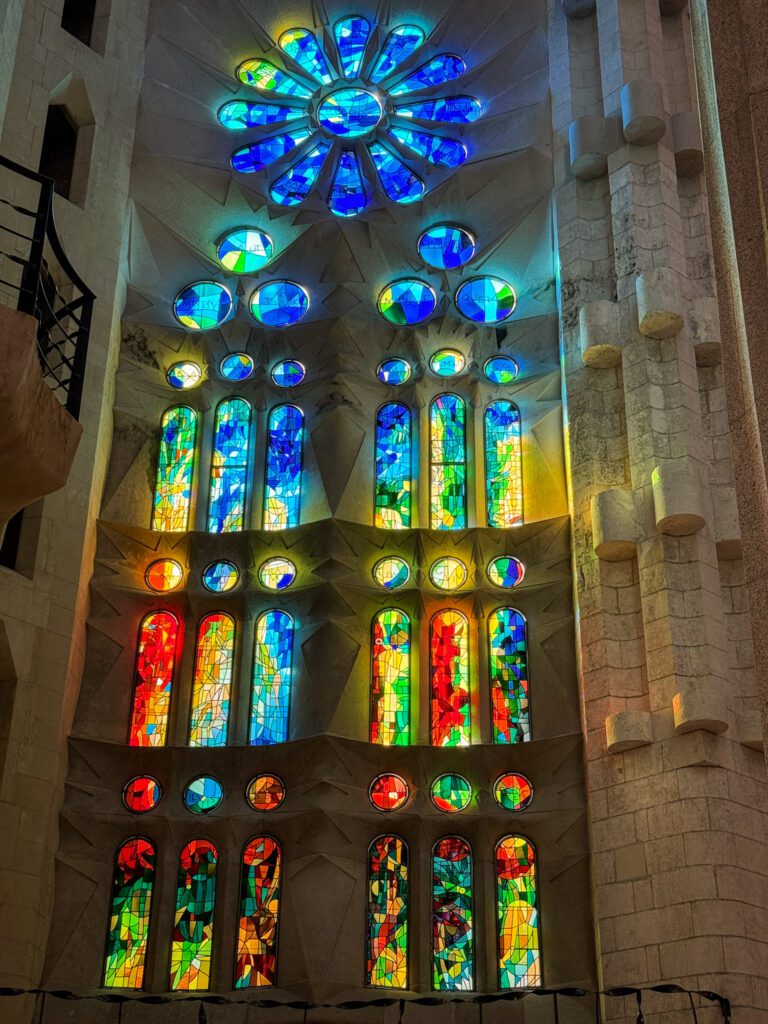
According to our guide, Miguel, on the Gaudí tour I did on my most recent trip to Barcelona (which includes La Sagrada Familia), midday is the worst time to be in the basilica because of both the crowds and the lack of light coming through the stained glass windows.
How to Visit the Sagrada Familia
First of all, if you’re in Barcelona in peak season (read: summer), you need to book your tickets for the Sagrada Familia well in advance.
They will sell out, and you’ll be left with a couple of options in that case that are going to be more expensive. We’ll get to those in a second.
You have two main options here – visit independently, or as part of a guided tour.
To get tickets on your own, you’ll need to go to the official website and hit the big red button that says “TICKETS”.
At the time of writing, tickets are 26 Euros a person (includes entry and the audioguide, which is phenomenal). For 30 Euros, you can do a guided tour with a live guide in place of the audio guide.
For 36 Euros, you can climb one of the towers (only one of them) for great views out over Barcelona.
You will then have to choose a specific day and entry time for your tickets, which will depend on your particular schedule. Do it as early as possible if you can!
Pro-tip: Make sure to bring headphones with you and download the audioguide on your phone in advance to listen to it as you go!
What if tickets are sold out? If tickets are sold out through the official website, you have two options. Check on Get Your Guide to see if they have Skip-the-Line tickets available, or join a guided tour of the Basilica.
If you’re interested in a guided tour of the Basilica, we’d recommend going with Walks, one of our favorite tour companies in Europe. We’ve done multiple tours with them (read about our awesome Colosseum tour in Rome) and the guides are some of the best around. They have a specific 90 minute Sagrada Familia Tour, and a more comprehensive Gaudí Tour (that I did on my last trip to Barcelona) that visits La Sagrada Familia along with Casa Batlló (or Casa Vicens) and Park Güell over the course of five hours.
An Afternoon in Barceloneta
After your Sagrada Familia experience, make your way south to the waterfront to Barceloneta for lunch and a history lesson that should last most of the afternoon.
When you’re in the heart of Eixample or the Gothic Quarter, it’s easy to forget that Barcelona is actually a seaside city.
Originally, I thought of Barceloneta as exclusively an area for the beach, which is a wide, sandy affair on the Mediterranean.
We’re not huge beach people, so we kind of dismissed it and completely neglected including it in an earlier version of this guide.
However, after connecting with two locals on my latest trip during/after tours, I can firmly say that there’s A LOT more going on in Barceloneta than just the beach (spoiler: it’s mostly great food and drinks).
I actually had the privilege of walking through Barceloneta with Elvira, my guide on my walking tour with With Locals (highly recommend both the tour and Elvira as a guide!), and that’s when it clicked for me that Barceloneta is more than the beach.
We went to Mercat de la Barceloneta, which is a cornucopia of Catalan food (though I have Celiac Disease, which is a lot more complicated).
To get there, we walked through the narrow streets lined by tall apartment buildings adorned with Catalan flags, and I realized that “oh yeah, people live here.”
Barceloneta as a neighborhood is a triangular manmade peninsula that juts out into the Mediterranean, bordered by the sea, El Born, and Poblenou (and Parc de la Ciutadella).
Generally speaking, the closer you get to the beach at the southern tip, the more generic it becomes.
This part of the city has a high concentration of vacation rental listings, and their presence is hollowing out the neighborhood, forcing locals out as landlords chase the tourist money.
Barceloneta Beach, located in a former fishing district, is one of the city’s oldest and best-loved beaches.
The whole waterfront area was remodeled way back in 1992 for the Barcelona Olympics, and today, this long strip of sand is a firm favorite with both tourists and locals alike.
Barceloneta Beach may not have the architecture or urban feeling of the inner city, but it’s still a great spot for an afternoon stroll, and an excellent place to grab an ice cream and indulge in a little people watching.
Instead of focusing on the beach, though, you’re really here for the food, the market, and the Catalan History Museum, which is an eye-opening experience for those of us who haven’t really learned all that much about Catalonia.
The Museu d’Història de Catalunya
Start your exploration of Barceloneta with the Museu d’Història de Catalunya, which was our favorite museum in Barcelona because it covers a subject that we didn’t really know all that much about prior to visiting.
The great thing about this museum is that it’s both cheap, at just 4 Euros per person, and has many of the signs in English.
Bring your headphones because there’s also a handy audio guide that you can use the museum’s wifi to listen to as you browse, but it’s not totally necessary since most of the signage has an English translation.
It’s worth spending between one and two hours here exploring the two floors of the museum.
You’ll have to check your backpacks and you’ll need a 1 Euro coin to do so, but we learned (thanks to the friendly man at the front desk!) that the coin you put in to lock the door will be returned to you at the end, and it’s just a deposit to make sure you don’t run away with the key (for some reason?).
More information on the museum, including current hours and ticket prices, on their official website.
Barceloneta Market
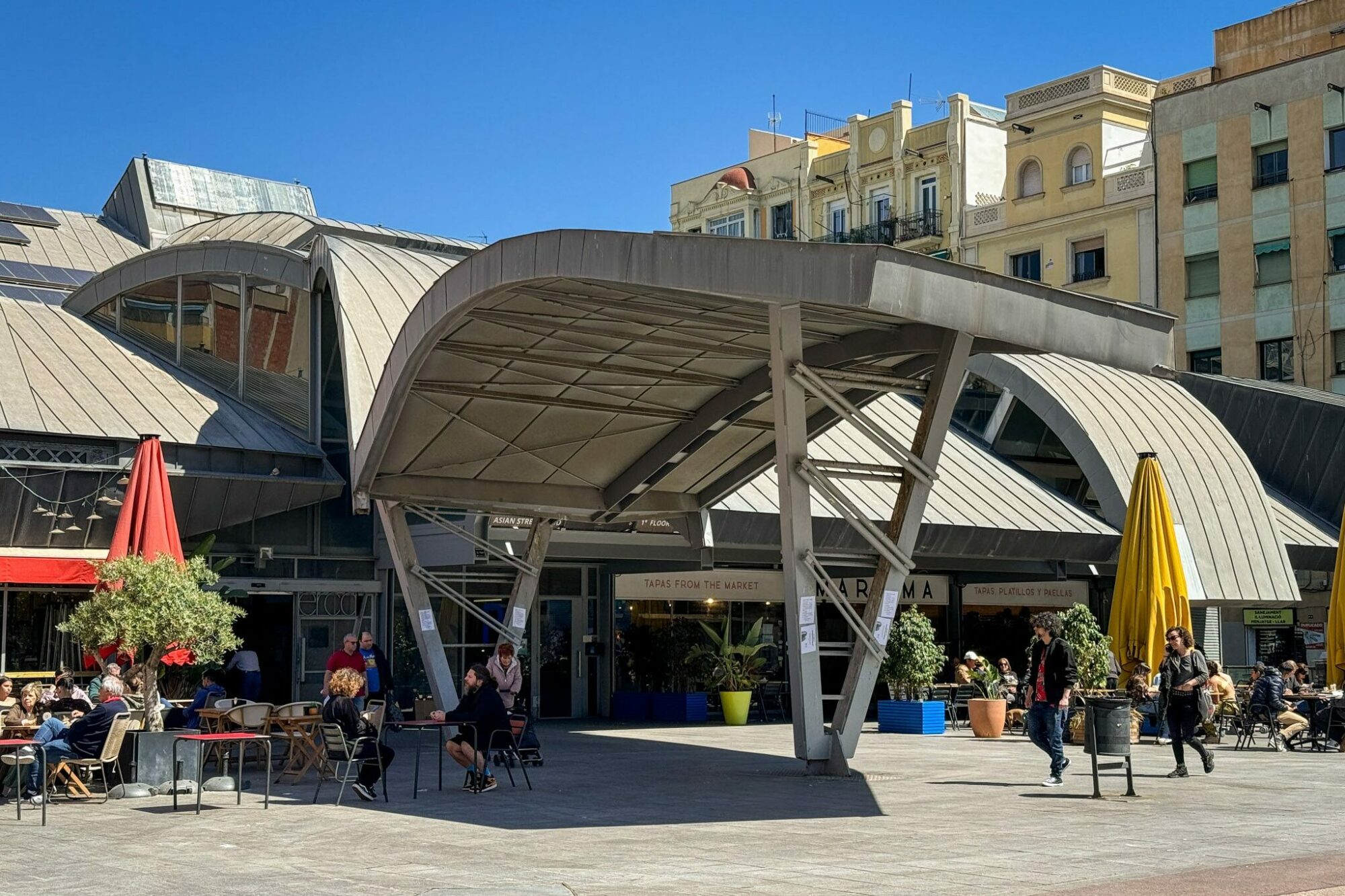
After the museum, make your way over to the Barceloneta Market.
One of our favorite aspects of Spanish cities is the fact that in Madrid, Sevilla, and Barcelona, there is essentially a neighborhood market in each of the main neighborhoods.
La Boqueria, for example, is one of them (though it has kind of been transformed by tourism into a more “Central Market” vibe that you’ll often find in European cities).
Barceloneta Market is, as you might imagine, the local market in Barceloneta. It’s significantly less touristy than La Boqueria, but still somehow packed to the gills with a mixture of locals and tourists.
It’s best in the morning through lunchtime, and the market closes for the day at 2:00 pm.
You can either find a place to eat here, pick up some picnic materials and head to the nearby beach, or simply wander the stalls and admire the bounty of fresh produce, fish, and meat before heading out for lunch nearby.
Tapas for Lunch
For lunch, you have three options nearby that are on every list of the best food experiences in Barcelona (and our local guide actually recommended these without us even asking about them).
First is Perikete, a no-frills tapas bar with outdoor seating and big hunks of meat hanging from the ceiling.
Order tapas – we like the fried padron peppers and patatas bravas – and wash it down with a cheap glass of vermouth, cava, or a beer.
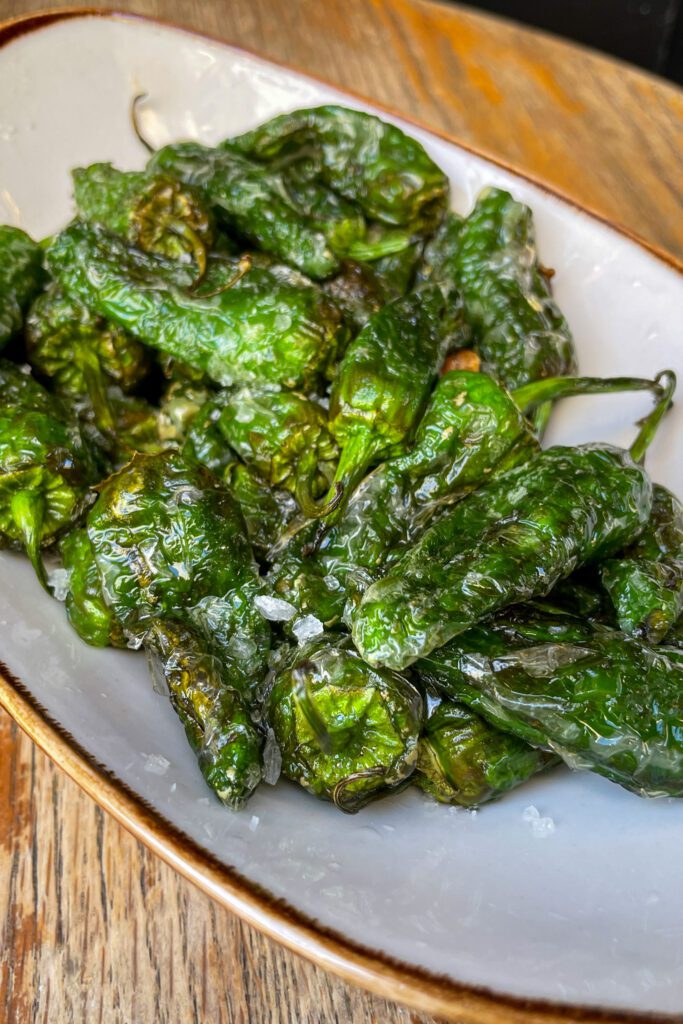
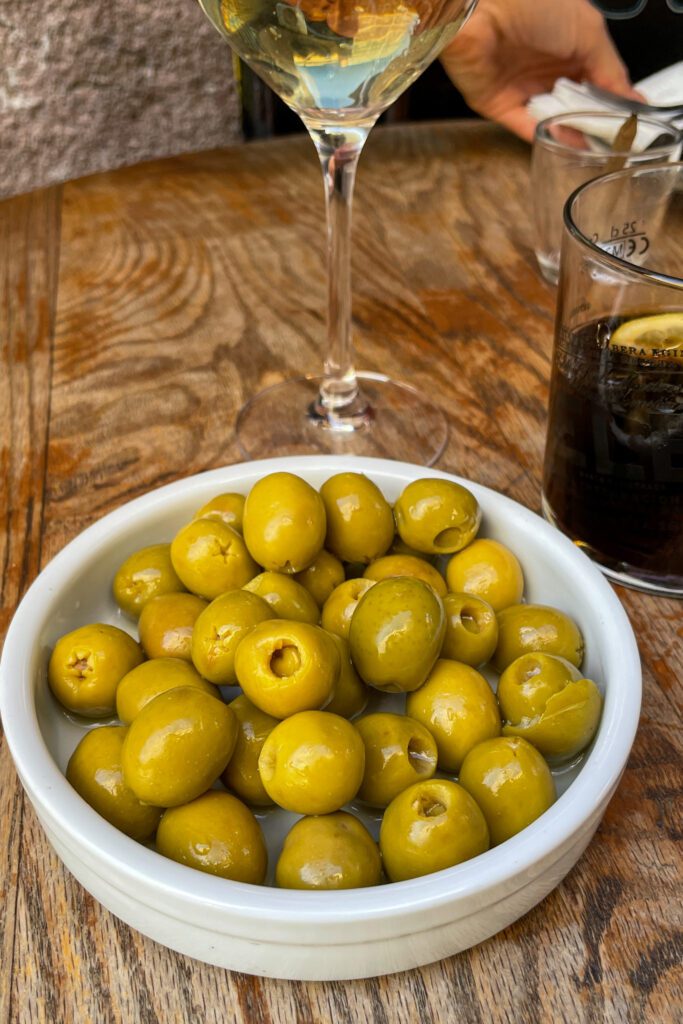
Second, just around the corner, is Can Paixano, a cava bar where locals and tourists alike eat shoulder-to-shoulder in the tiny space. There’s always a line for lunch, but it moves fast.
For lunch, you can choose from a range of tapas and bocadillos, which are basically little sandwiches. And, of course, cava.
Regular cava. Nice cava. Pink cava. All the cava, please! (note: no gluten free options for food here, sadly – if you need to eat gluten free, make sure to read our guide to gluten free Barcelona!).
Pro-tip: If the server isn’t paying attention to you after your first glass of cava, it’s because you need to order more food to go with it (thanks to Miguel, our walking tour guide, for the tip!).
Last is a tiny, historic tapas spot in Barceloneta that Elvira (my guide for the history-focused walking tour) recommended and actually took me to – though I was hesitant because I have Celiac Disease – called La Cova Fumada, which is a great place to try local Catalonian specialties like bombas (which were actually created in Barceloneta).
An Evening in El Born
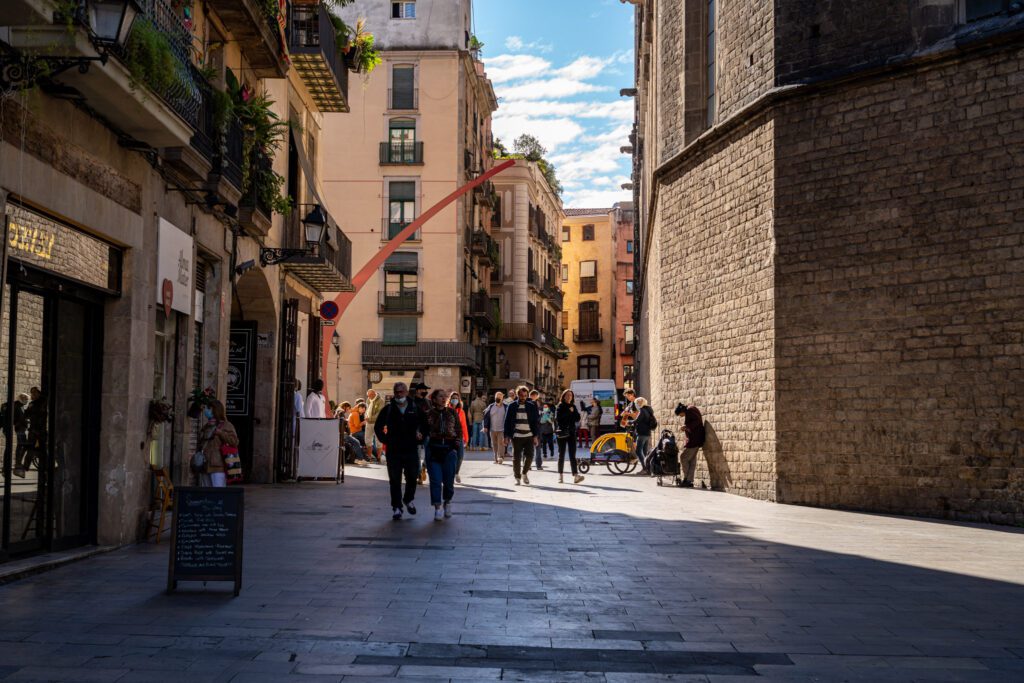
After your leisurely afternoon in Barceloneta, spend the evening in nearby El Born, known for its food scene and great nightlife.
Here are some things to do in El Born and nearby, in no particular order:
- Get coffee at Nomad Coffee Lab (my personal pick for the best coffee in Barcelona, particularly this location) or Hidden Coffee Roasters, some of the best specialty coffee in Barcelona.
- Explore Ciutadella Park and walk out to the Arco de Triomf (every European city has one!).
- Make a detour into the Gothic Quarter for the best tea we’ve ever had at Salterio. No joke. The Yogi Tea is incredible, and the family running the place is super friendly and welcoming. Caj Chai and La Masala Cafe are close seconds, though, and both are nearby.
- Visit the Basilica of Santa Maria del Mar after 5:00 pm, when the interior of the church is free! We’d recommend going inside this church over the Barcelona Cathedral.
- There are an endless number of bars and restaurants to choose from – we liked Flax & Kale Passage for vegetarian, internationally-inspired food (the Malaysian Curry is great!).
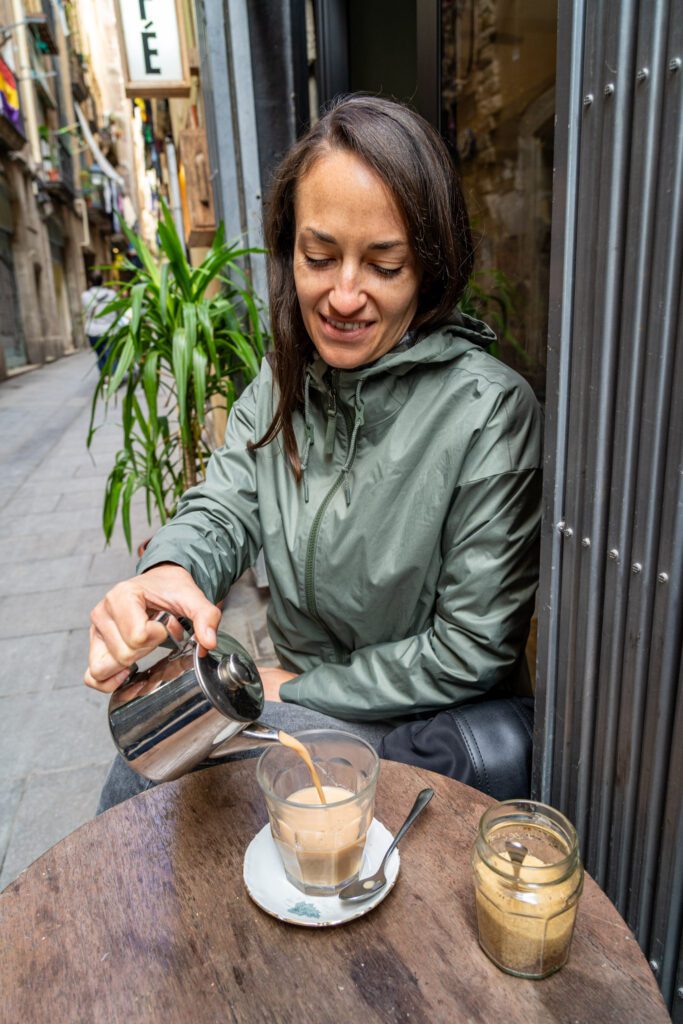
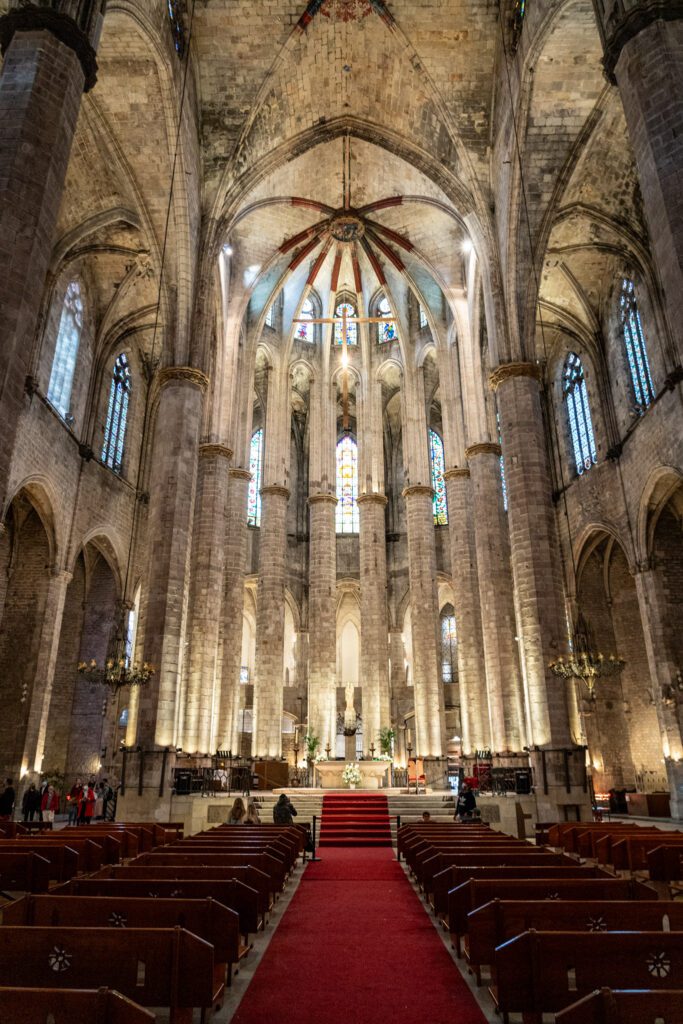
If you’re up for an after-dinner drink, here are a couple of spots you might enjoy in El Born:
- El Diset: A cocktail + wine bar with a focus on Catalan wines with a selection of tasty tapas if you arrive earlier in the evening.
- Paradiso: This bar feels like the beginning of a spy movie. You’ll start your visit in an unassuming Pastrami bar, before opening a refrigerator door (yes, really), to reveal the entrance to a super cool speakeasy with expert mixologists and world famous cocktails.
- El Xampanyet: Less hipster and more traditional, this tavern style bar is a local favorite, with all the hallmarks of a Catalan tapas bar: stand up socializing on tiled floors, barrels stacked behind the bar and a steady supply of snacks throughout the evening.
Day 3: Choose Your Own Day Trip Adventure
On your third day in the city, we’d take advantage of Barcelona’s proximity to multiple great day trips to get out of the city and get deeper into Catalonia.
There are two day trips in particular that we’d recommend as our top two options, and each offers something a little different, and which one you choose kind of depends on what you’re into.
The first is Girona, a charming medieval city with intact walls, and the second is Montserrat, a cathedral in the rocky mountains above Barcelona with some nice hiking options.
We’ll cover both in this section so that you have the ability to choose which you’d prefer.
We do want to add a plug for Tarragona as an honorable mention, which I went out to check out because it was the original Roman settlement in the Iberian Peninsula and has tons of somewhat well-preserved Roman ruins.
If that sounds like something up your alley, I’d highly recommend this guided tour with Bernat, which I did and enjoyed because Bernat is able to bring a ton of historical and cultural knowledge and context to help you understand the history of not only the city, but the region as a whole.
Option 1: Girona, the Charming (Catalonian) City with Medieval Walls
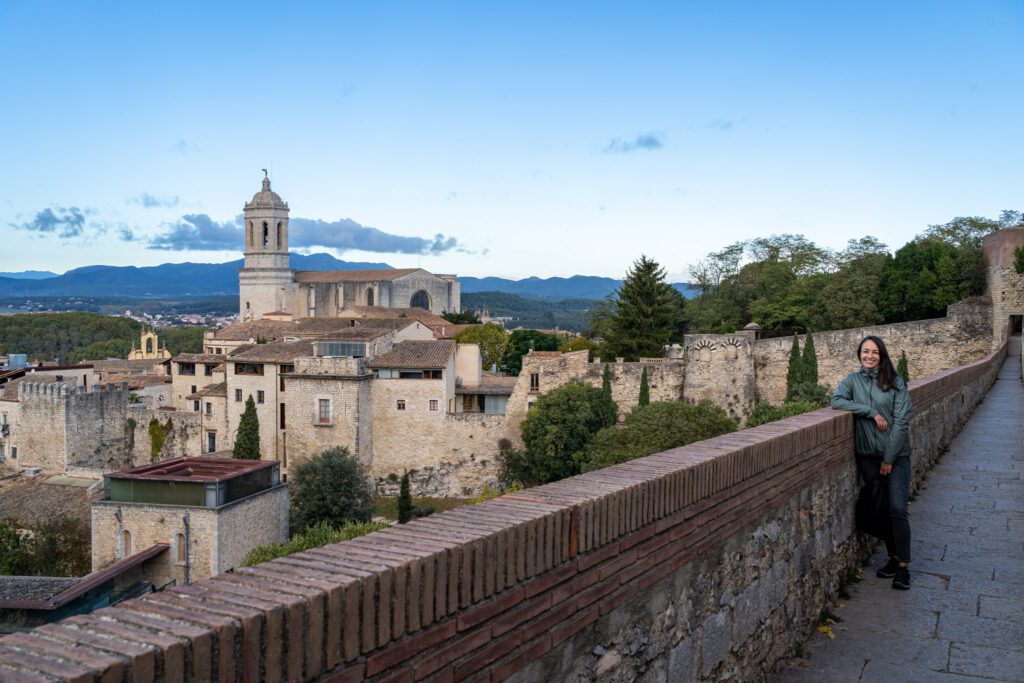
We’d highly, highly recommend a day trip to Girona to dive deeper into Catalonia. It was the day trip we chose to take from Barcelona on our first trip, and we really, really enjoyed it.
It’s a gorgeous town at the convergence of multiple rivers about 100 km northeast of Barcelona. So beautiful, in fact, that Game of Thrones filmed several major scenes in Season 6 in Girona!
We have an entire guide dedicated to planning a day trip to Girona from Barcelona, which you should read for more details. Otherwise, here are the highlights.
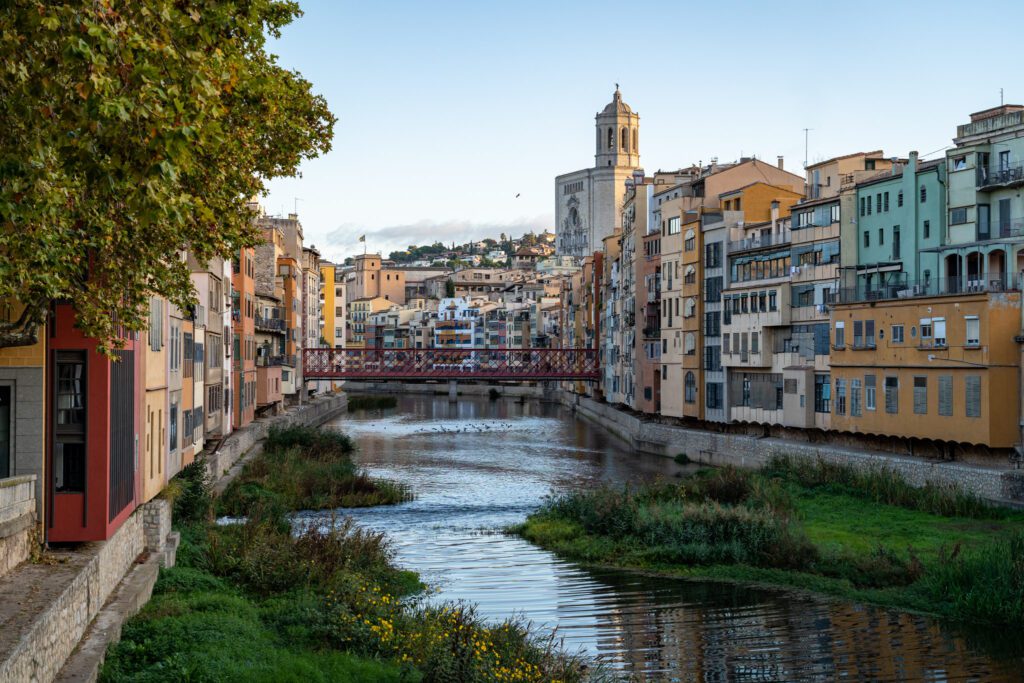
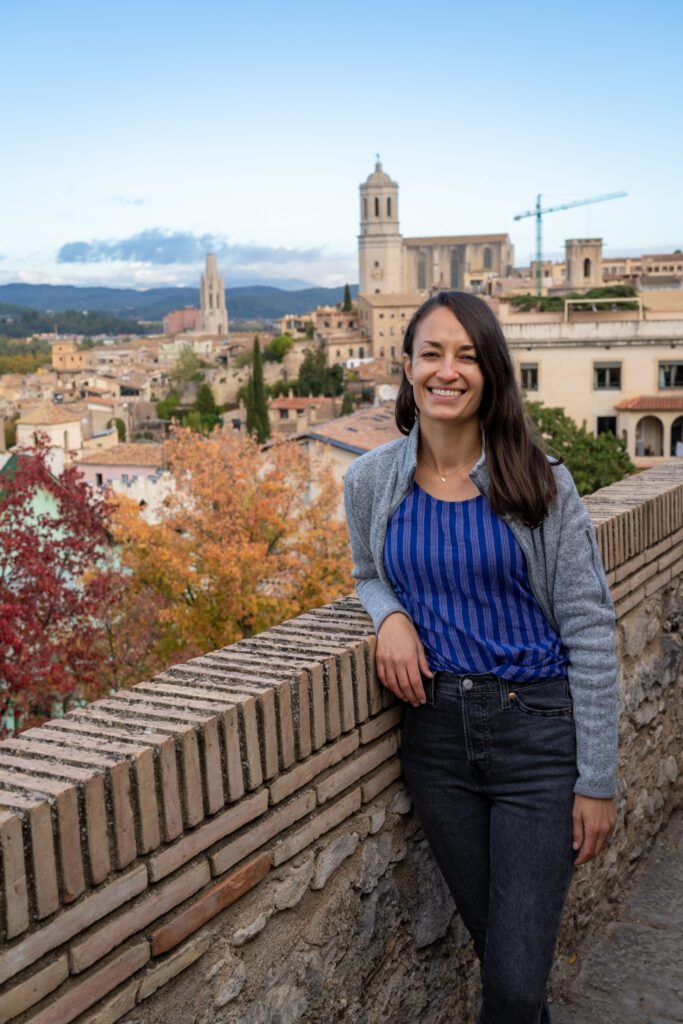
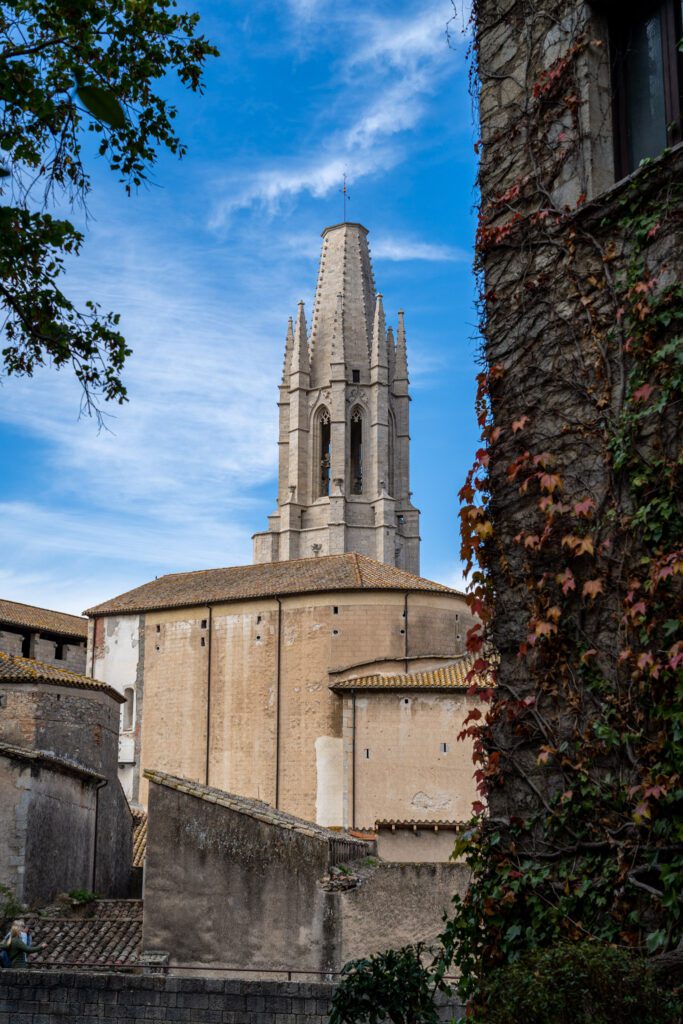
Getting to Girona
Take the high-speed AVE train from Barcelona-Sants to Girona, which takes just 40 minutes each way. Book tickets either directly through Renfe, or through Omio for a more user-friendly experience (that comes with a small service fee).
We recommend the 7:05 am train if you can stomach it, which will get you there with plenty of time to do some exploring before meeting up with the best walking tour we did in Spain.
Then, catch a train home AFTER 6:00 pm – the siesta is real in Girona, which means everything closes from 2:00 to 5:00 pm or so. A later train will give you time to make it to some of the places you miss during the siesta time.
What to Do in Girona
Again, see our entire guide to one day in Girona for many, many more details, but here is the gist of how we’d spend a day in Girona (and, essentially, how we did it ourselves).
Arrive early and walk the city walls before it gets packed.
You can get up onto the walls from the Jardins de la Francesa behind the massive cathedral (here on Google Maps), and they continue alllll the way around back to right around Plaça de Catalunya (though you can get off the walls at several points between those two spots).
Don’t miss climbing up into at least one of the towers along the way for great views of the city and cathedral!
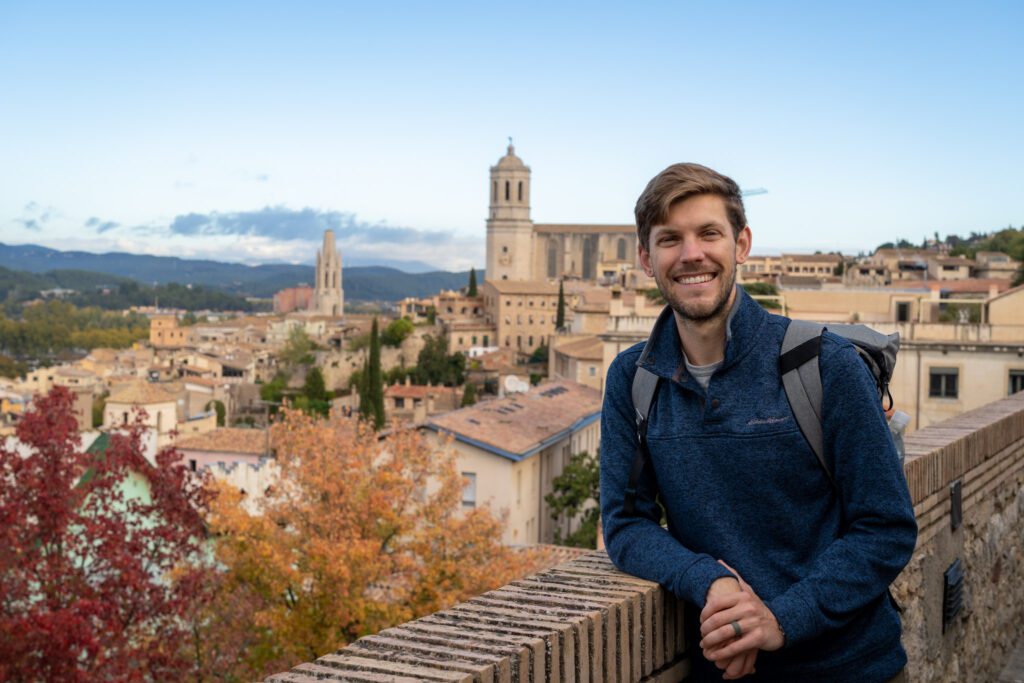
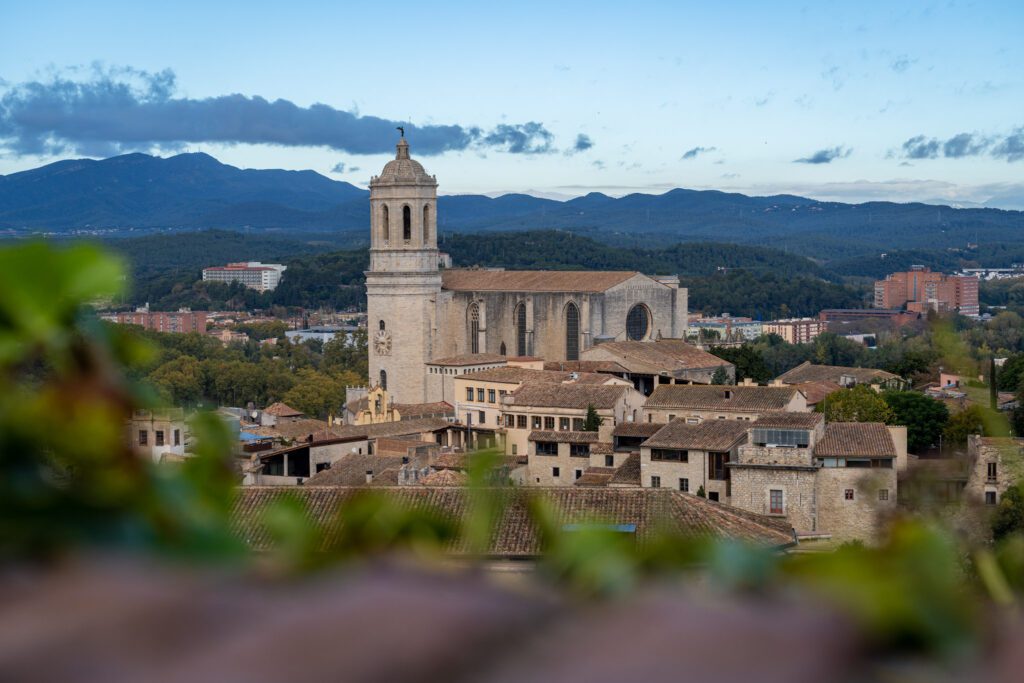
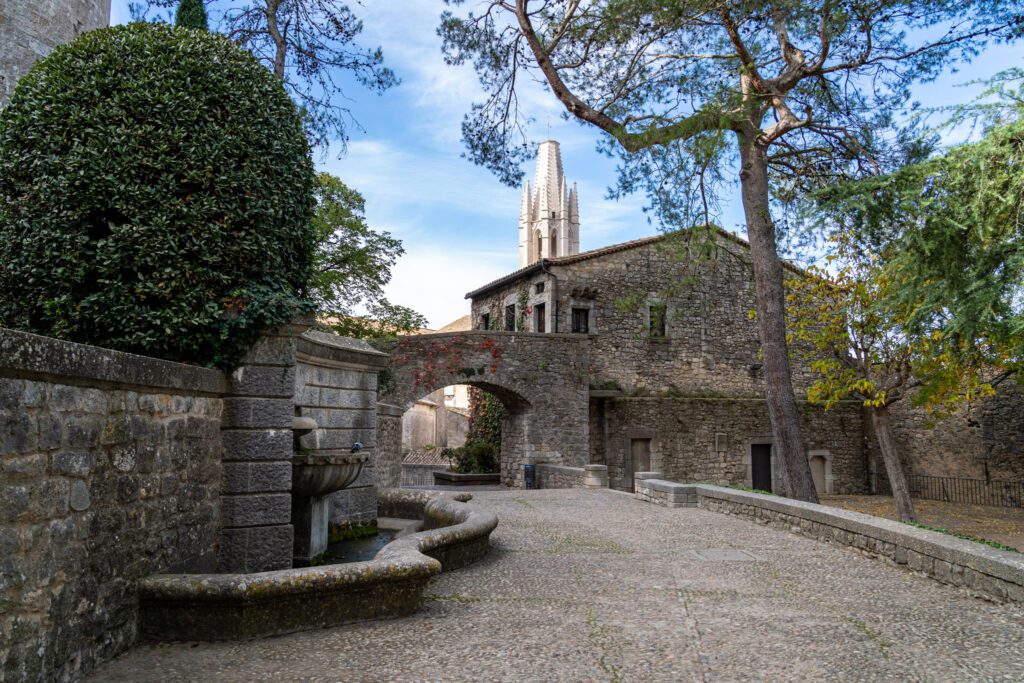
Head down to Espresso Mafia for the best coffee in Girona and a pastry or two, or over to their sister cafe La Fabrica if you’re in the mood for a more hearty brunch.
Join our favorite walking tour in Spain at 10:30 am. And the best part is, you have two options!
We loved the history-focused walking tour we did with Raquel, whose knowledge about Girona and Catalonia as a whole was impressive, and it’s the one we’d recommend for most people.
However, they also do a Game of Thrones Tour, which fans of the TV show (minus the last season of course, which was hot garbage) will appreciate because it takes you to places in the city where they filmed pieces of Season 6.
After the tour, grab lunch somewhere in the old town (ask your guide for a recommendation!).
During the siesta, where the entire city basically shuts down for a few hours in the afternoon, hit the informative Jewish History Museum.
The museum covers the history of the Jewish population in Girona, which shaped the city prior to them being expelled in 1492.
Then check out the Girona Cathedral, which is home to an impressive cloister, a huge nave (with no arches in the middle, which is unique) and the Tapestry of Creation from the 11th (ish) Century.
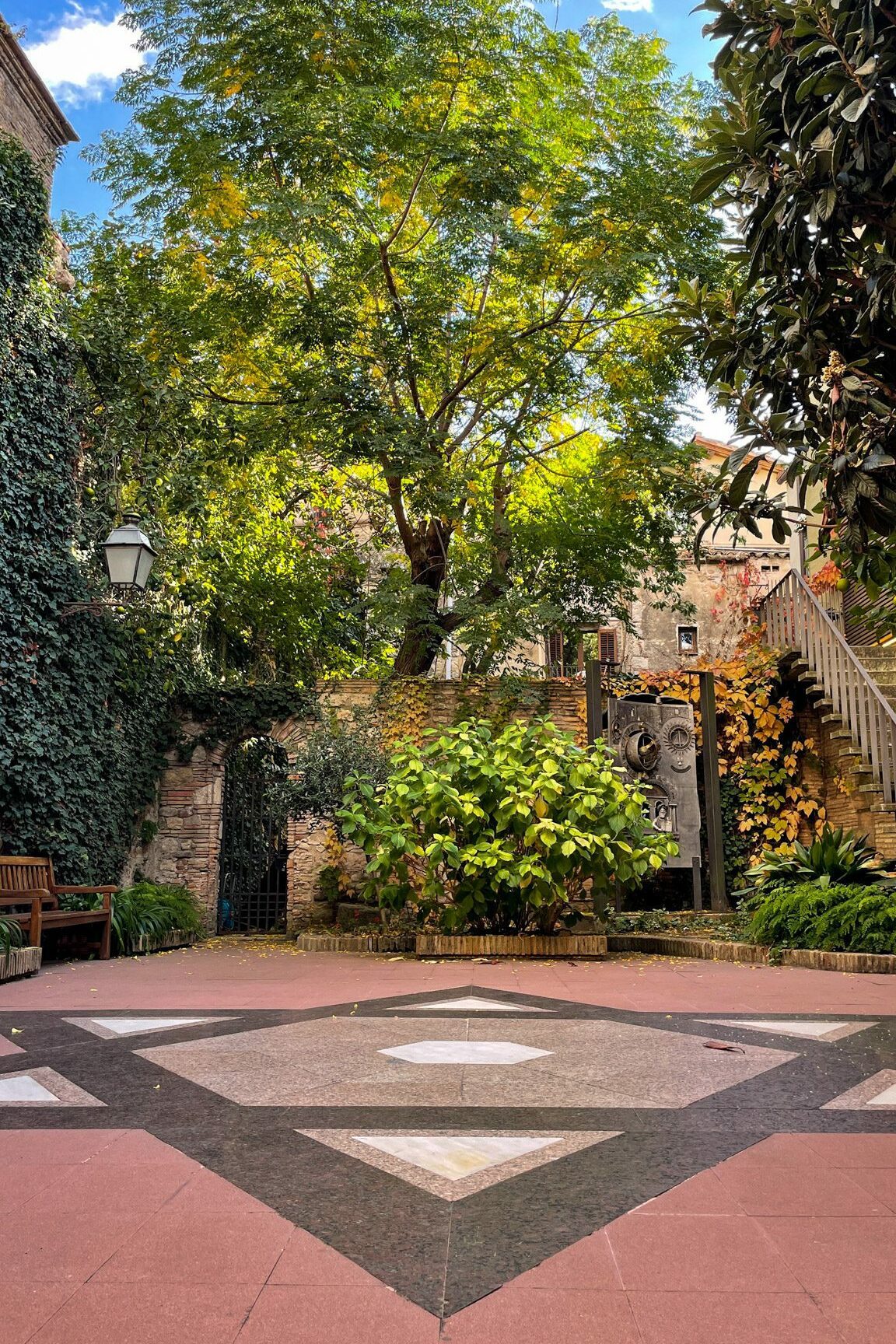
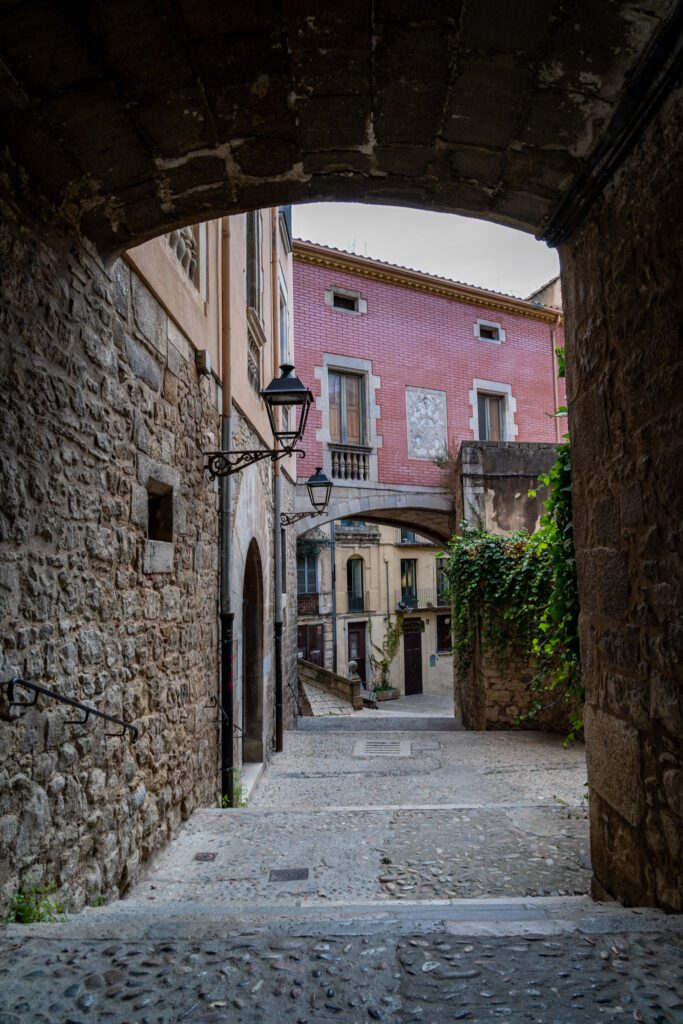
Afterwards, spend the rest of your time wandering the old town and stopping into any place that catches your eye before catching your train home!
Option 2: Montserrat – the Basilica in the Mountains (+ Hiking)
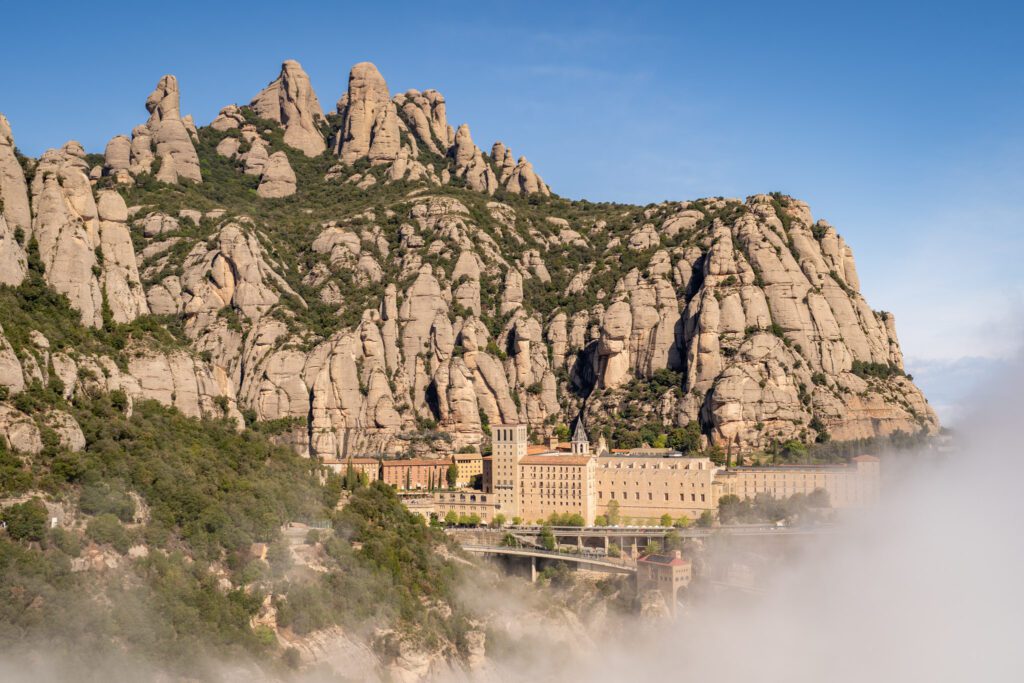
Montserrat is a holy site just outside of Barcelona that sits atop a rocky outcropping that absolutely does not look like it belongs in the same place as the surrounding landscapes.
It’s not surprising that someone hundreds of years ago said “yeah, this is a special place” and set up shop.
Since then, Montserrat has become a destination for pilgrims (kind of like the Camino de Santiago, but less famous).
Today, the two main attractions are the basilica atop the mountain – Basílica de Montserrat and the “Black Madonna” that sits atop the altar (the basilica’s holy relic), also known as “La Moreneta” – and the views from the hiking trails that leave from the abbey and basilica.
If you want to do both the basilica and head out on a short hike, you’re looking at a 5-6 hour trip, including transportation (depending on a lot of factors).
We’d STRONGLY recommend heading out on the first train of the day from Barcelona, because it does get very crowded here (especially on weekends, and particularly on Sundays).
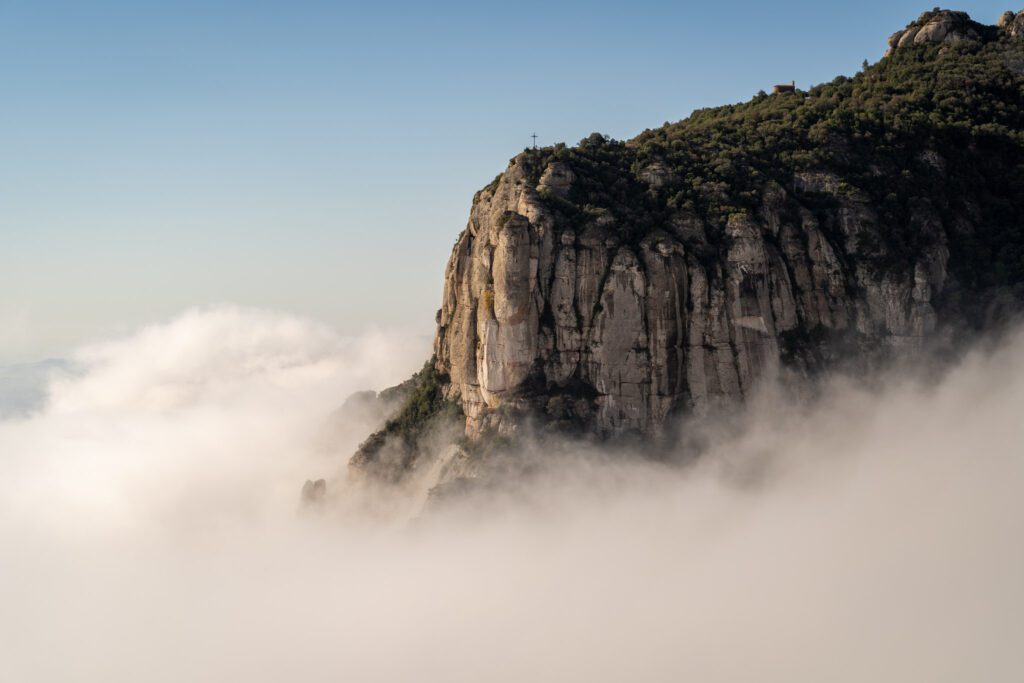
I actually did this guided tour with a local company – which includes the transportation to Montserrat from Barcelona – for a couple of reasons.
One, I was traveling solo, and wanted to connect with other people. Two, I was deep into my trip and I didn’t want to deal with all the logistics of getting there, which is a little bit complicated.
I enjoyed the tour, and thought our guide Christian added a ton of context and information about the monastery and surrounding area.
The main downside of the tour is the flexibility to explore at your own pace. Want to see the Boy’s Choir, do the Museum, or go on a longer hike? You’re at the whims of your group.
Getting to Montserrat
This is a significantly more complicated journey than the journey to Girona, because it involves multiple forms of transportation.
There are two legs of this journey: the journey to the base of the mountain, and the journey to the abbey.
First, to get to the base of the mountain, you need to get to Plaça d’Espanya (the regional train station), where you’ll hop on the R5 regional train towards Manresa-Baixador.
Which stop you get off at depends on which form of transportation you’ll use to get to the top – more on that in a second.
Then, to get up to Montserrat, you have two options; the cable car (Aeri de Montserrat), or the train (really a rack railway).
They cost the same, and the better option is the cable car because it’s faster (it’s one fewer stop on the regional train, which is only around five minutes) and has great views along the way.
HOWEVER, if you are afraid of heights, do yourself (and your travel companions) a favor and take the railway.
If you are doing the cable car, take the regional train to the stop called “Aeri de Montserrat.”
If you are doing the rack railway, take the regional train one stop further, to the stop called “Monistrol de Montserrat.”
Again, our strong recommendation is to get on the earliest train leaving Barcelona that you can to beat the crowds out to Montserrat.
At the time of writing, the first train out is at 7:35am (leaving from Plaça d’Espanya – leave yourself plenty of time to buy your ticket and get to the train!), which puts you at Montserrat around 9am.
To buy tickets, you can either buy in advance on the official Barcelona Tourism site here (you’ll get a voucher that you have to exchange for a card once you’re in Barcelona), or buy them at Plaça d’Espanya on the day of your trip from one of the machines, which have an English language toggle (leave yourself plenty of time, because the machines can get busy).
Important note: If you buy the train tickets in advance, the pickup point does not open until 8am, so you will need to exchange the voucher for your tickets ahead of time (which you can do either at Plaça d’Espanya, or at the Tourism Office at Plaça de Catalunya which is in the basement).
Another note: There are other pre-book card options that include the museum and a meal in the cafeteria at Montserrat, but we would just recommend the train journey + basilica.
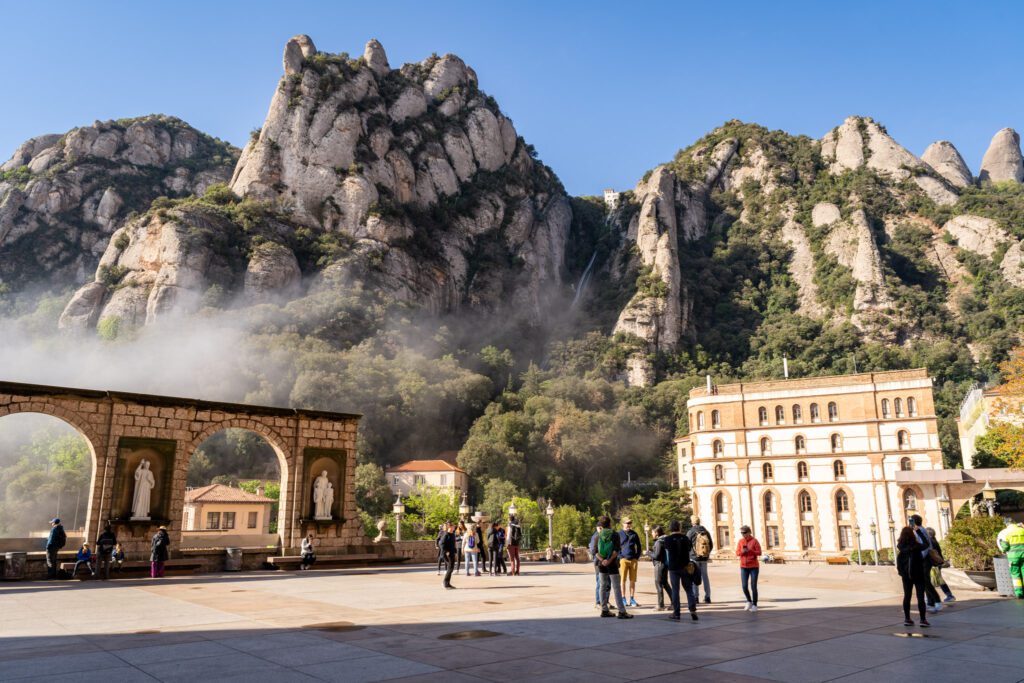
What to Do at Montserrat
There are several attractions to take in at Montserrat, but there are two main things we’d focus your time on.
The Basilica. The main “attraction” (though for us, it’s the hike), the Basilica de Montserrat is gorgeous, and really makes you wonder how they built it. Aside from La Moreneta, which requires a different ticket and line, I really liked the unique, ornate lamps that people send for good luck. It costs 6 Euros a person (extra if you want to touch La Moreneta) and you’ll want to book in advance and choose a timeslot that lines up with your itinerary.
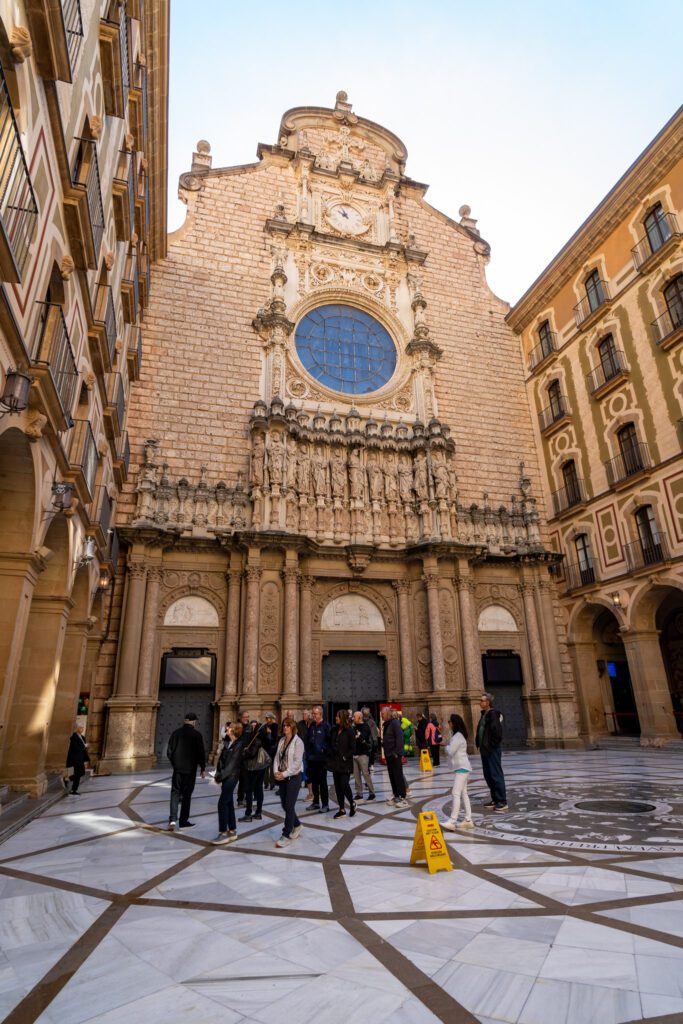
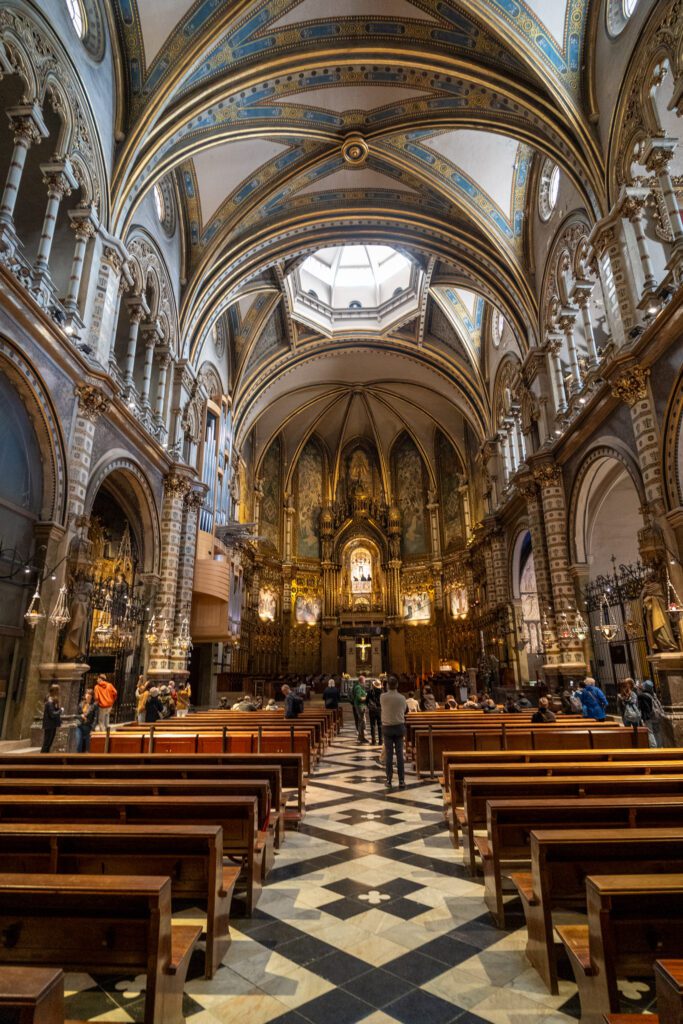
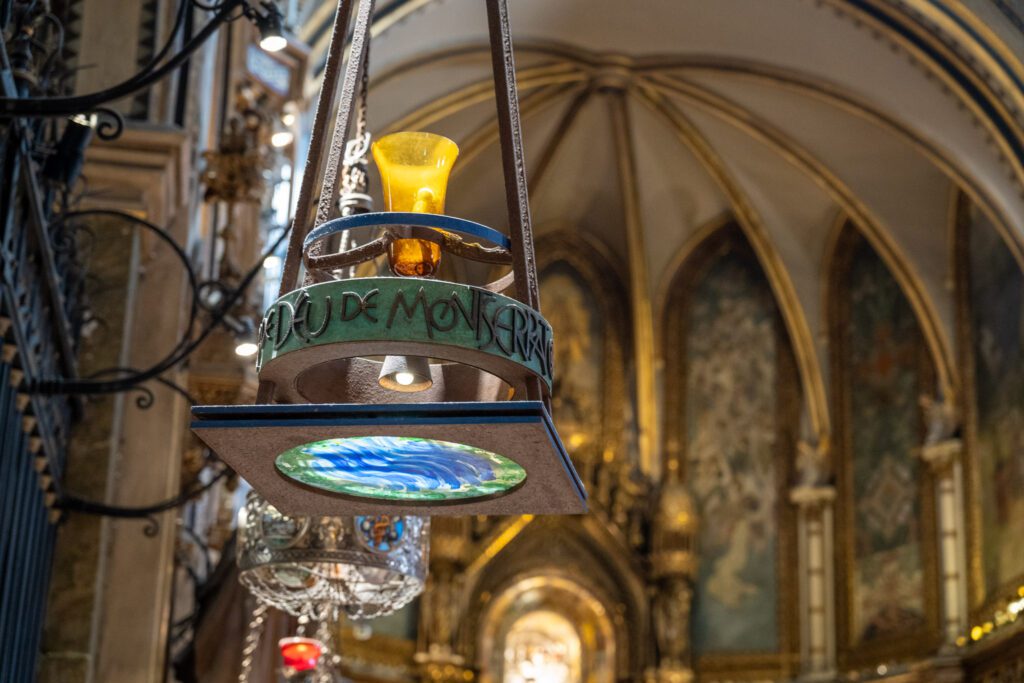
The hiking. There are a variety of hiking trails that leave from the Abbey and take you up the hill to various viewpoints (including a short hike to the top of the Saint Joan Funicular, which leaves from the abbey and climbs the rocky hillside to a higher point without hiking, if you prefer). Here are a couple of hiking options:
- To the cross of Saint Michael: Paved but steep path to a main overlook of the abbey and surrounding mountains. It’s relatively steep, but well worth the effort.
- To the Summit of Sant-Jeroni: By far the most difficult, this one is going to take you several hours to complete, and takes you to the summit (the highest point in this particular group of mountains). You can shave off a bit of distance and climbing by taking the Saint Joan Funicular, and starting your hike from the top.
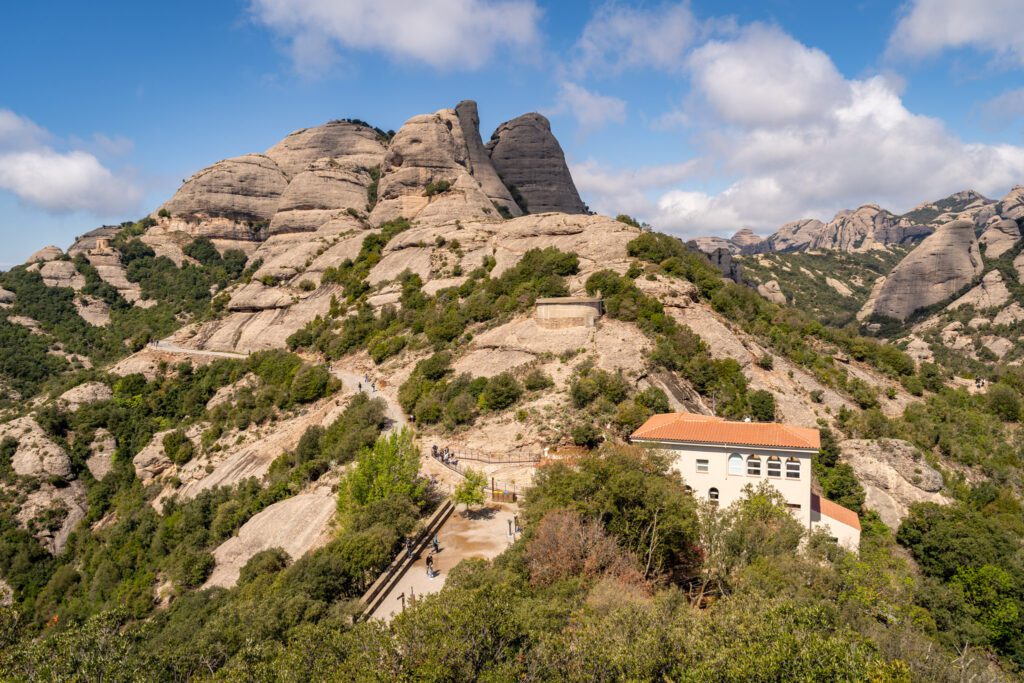
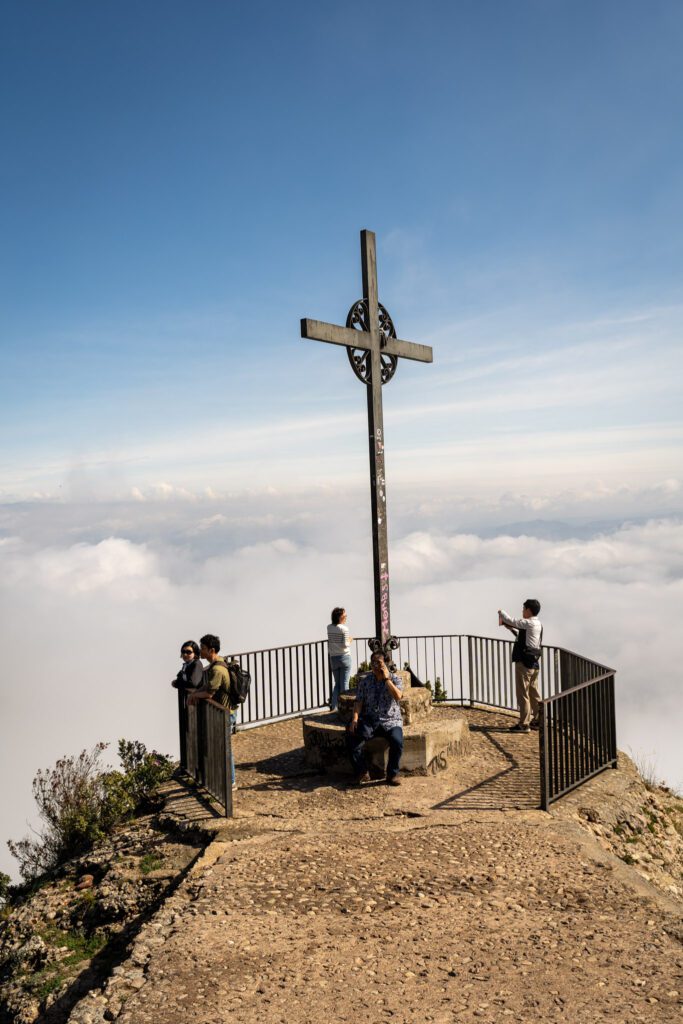
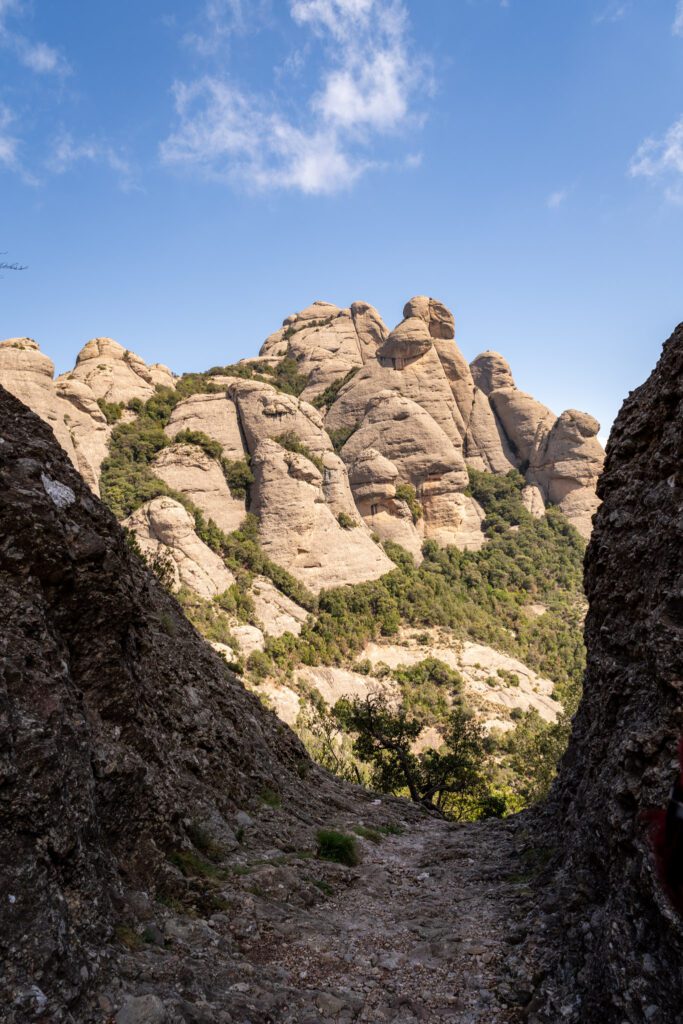
Other things, like the museum, the boys choir, and the farmers market, depend on how much time you have and what you’re interested in.
Tips for Visiting Montserrat
Here are a few tips to keep in mind before your visit to Montserrat.
Bring a backpack and some water. Especially if you’re hiking. It can get hot in the summer, and you want to have water and snacks.
Wear comfortable, closed-toe shoes if you’re hiking. Don’t try to hike in flip flops!
Pack a picnic lunch. The restaurants (really, cafeterias) at Montserrat are both underwhelming and expensive. Far better to pack a sandwich or some bread, cheese, and meats to bring with you to enjoy with a view.
Day 4: Park Güell & Learning to Make Paella
On your last day in Barcelona, check out Park Güell in the morning, then do a cooking class centered around paella before ending your trip to Barcelona in Gràcia, our favorite neighborhood in Barcelona.
Spend your morning relaxing, grabbing coffee and breakfast, and visiting a lesser-known Gaudí landmark, preparing yourself for an action packed afternoon and evening.
Casa Vicens: An Unexpected Delight
The least famous of Gaudí’s residential sites, Casa Vicens was an unexpected delight on my latest trip to Barcelona.
The added benefit of being a bit out of the way is that it’s A LOT quieter than the two houses on Paseo de Gràcia, but no less beautiful (in fact, I’d say it’s the most intricate).
It’s on a quiet street in Gràcia, a few blocks north of all the hustle and bustle, which puts you in perfect position for your afternoon plans.
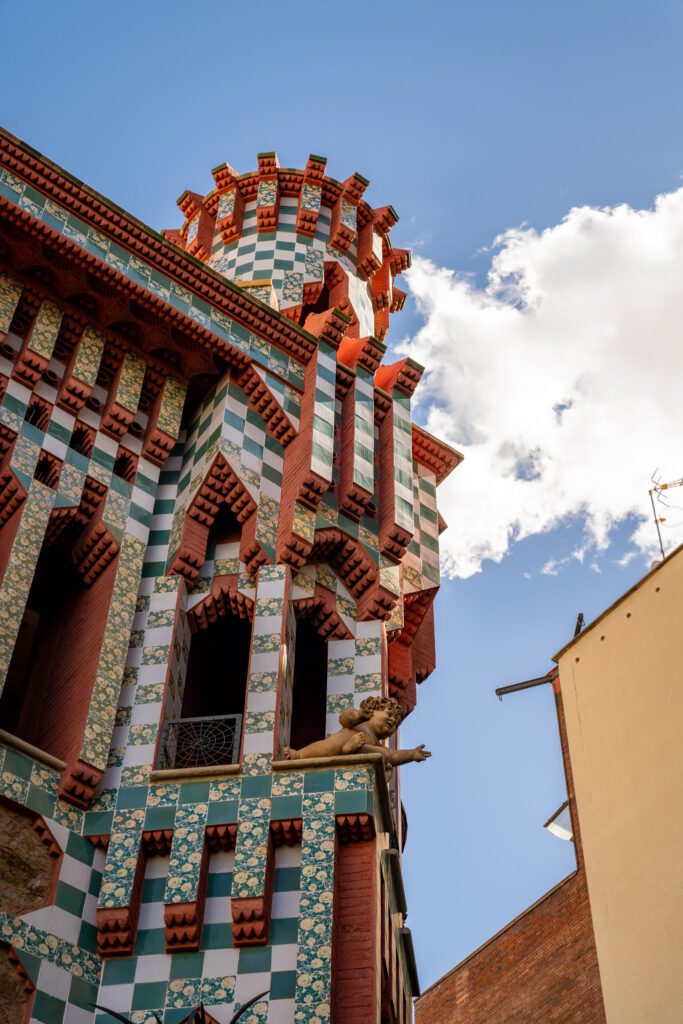
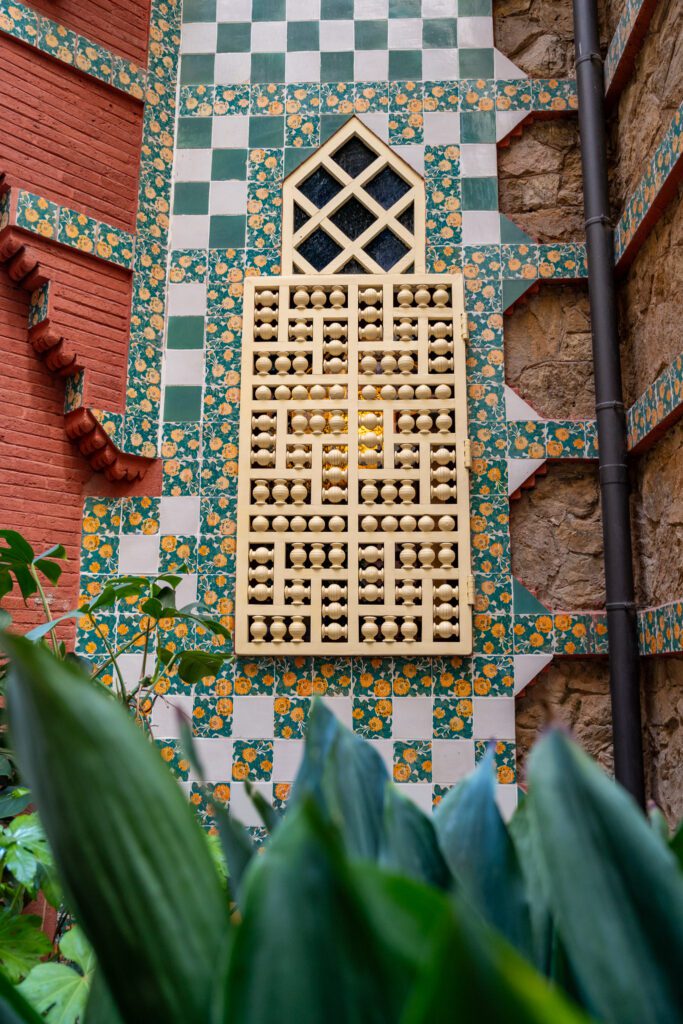
One of the things I first noticed about the design elements here is the influences from other styles – namely Mudejar, the architectural style you find in southern Spain inspired by the Islamic caliphate that inhabited the Iberian Peninsula for centuries (and there’s also something vaguely Japanese going on that I can’t put my finger on).
My favorite parts about the design are the interior patio and the fountain, the paper mache ceilings featuring all sorts of fun natural elements, and the rooftop terrace. Plus, all the tilework is absolutely gorgeous.
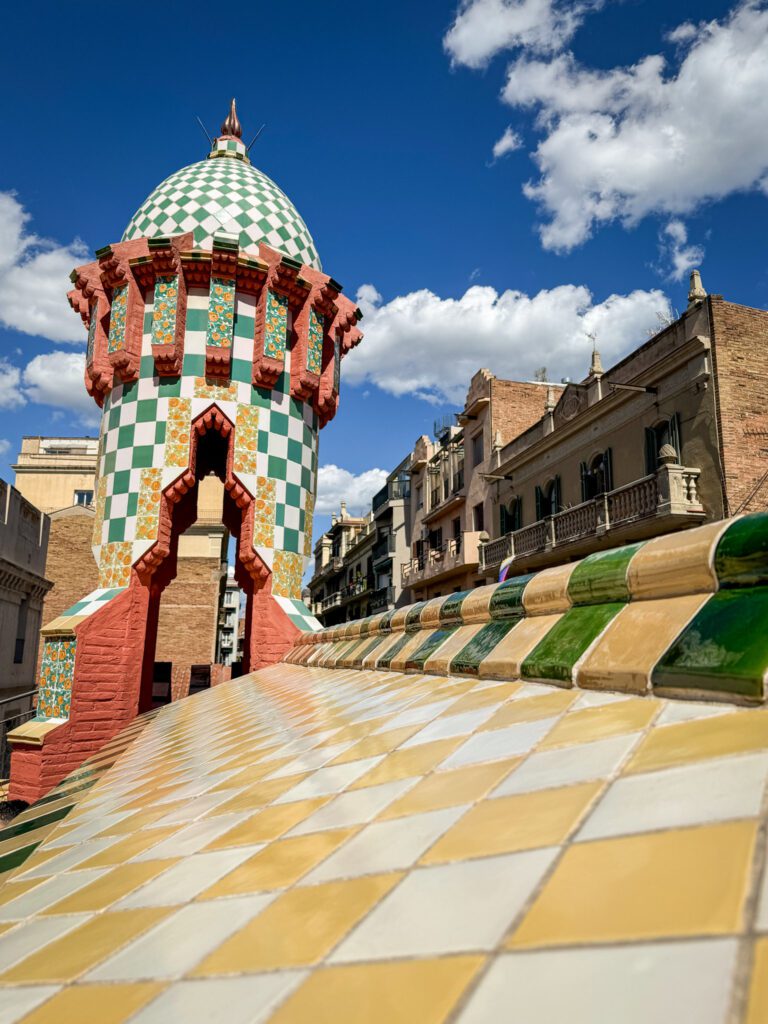
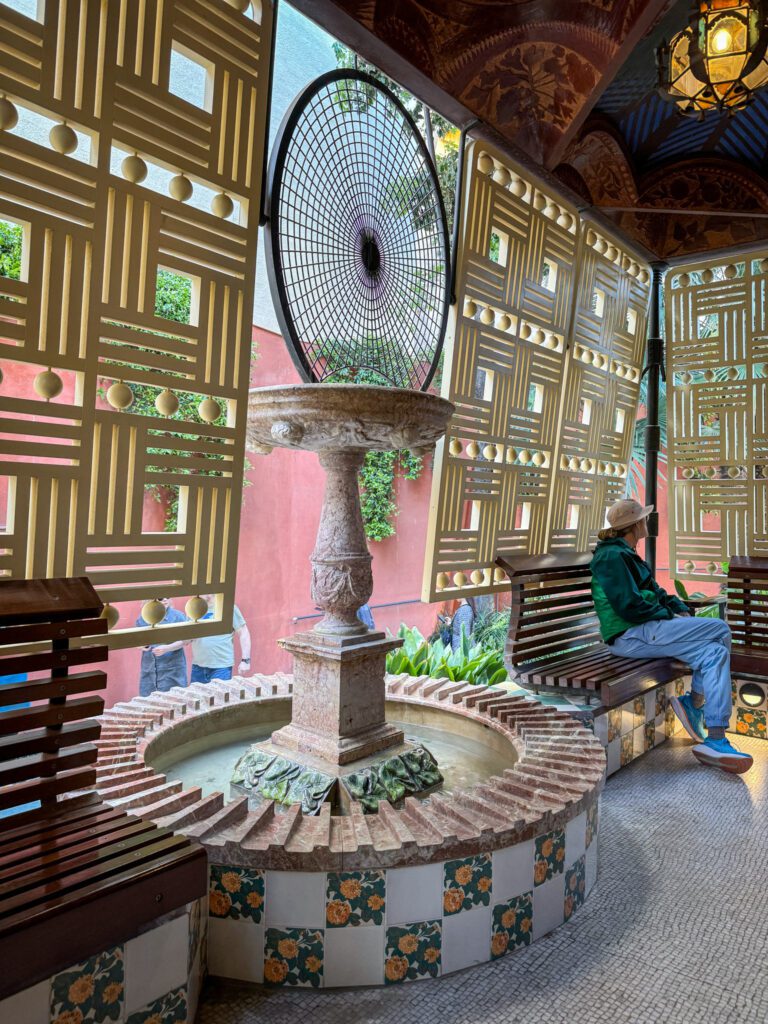
Part of the house is original, and part of the house is an extension built after Gaudí’s death by one of his students, matching his original style.
Despite the fact that it’s less popular than other sites like Park Güell and the Sagrada Familia, you should still book tickets in advance if you can. You can do it on the official website, and the base ticket is going to cost 18 Euros.
Learn How to Cook Paella in a Gorgeous Garden
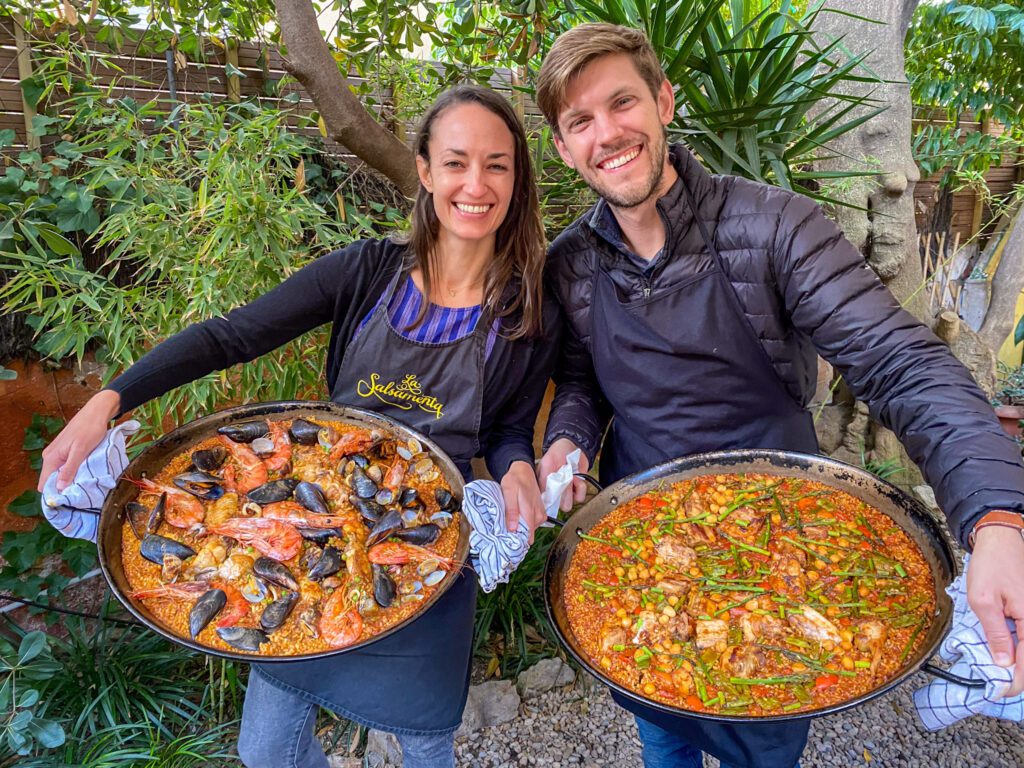
We personally did this cooking class, and it was a highlight of our entire trip to Spain (you can read their stellar reviews on Airbnb).
Did you know paella is a) traditionally a lunchtime dish and b) not from Barcelona, but from Valencia, which is further south down the coast of Spain?
In fact, paella from Valencia NEVER has any kind of seafood in it, which is generally what I thought of when picturing paella before this cooking class.
Frankly, we didn’t really know a whole lot about paella other than “it’s rice, and it’s from Spain” before doing this cooking class with Clara, who grew up in Barcelona and whose family still lives in the house behind the fabulous garden you’ll make the paella in.
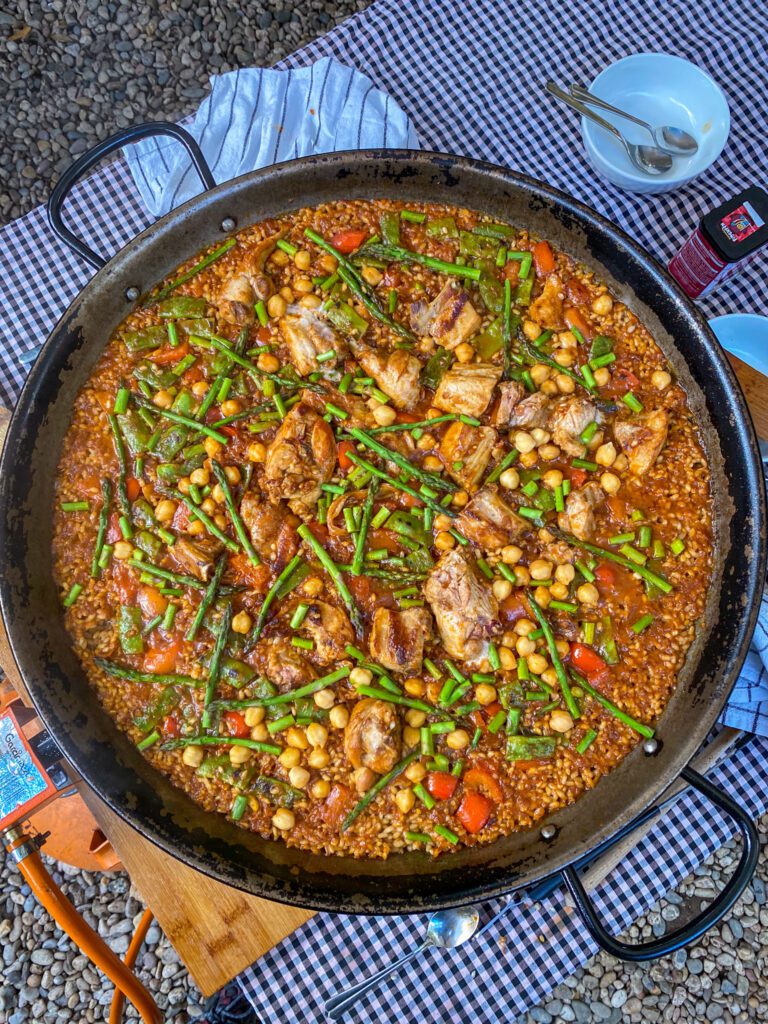
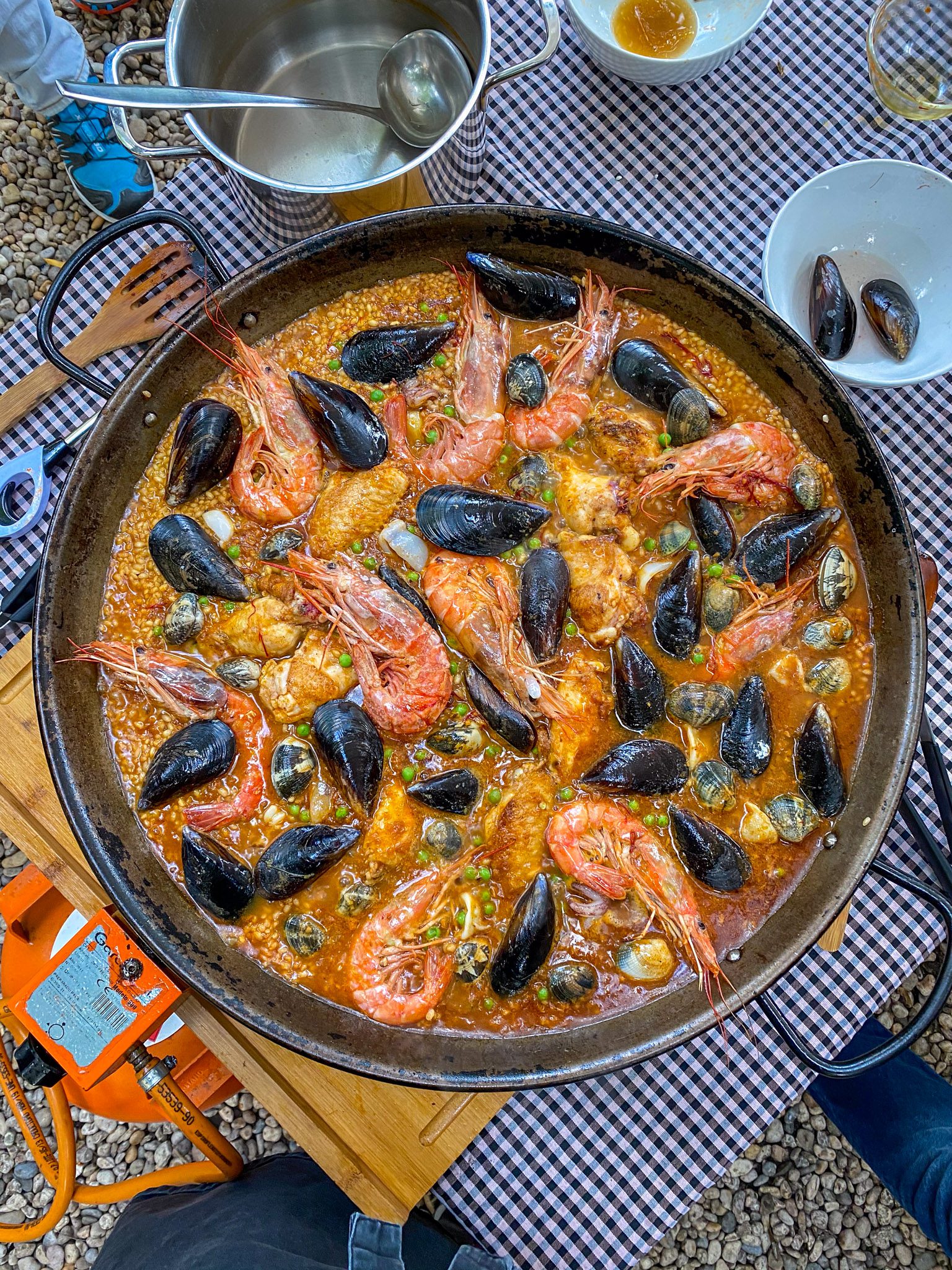
This class is usually at lunch (except on Fridays) and it’s a lovely afternoon spent cooking a couple of different types of paella, meeting both Clara and like-minded travelers, and eating tapas, paella, and drinking Spanish wine in a gorgeous setting.
The class lasts three hours, and we’d recommend not getting too drunk off of wine to make it to your next stop, which is one of the main attractions in Barcelona.
Click here to check prices, reviews, and availability of the paella class we did.
An Afternoon in Park Güell
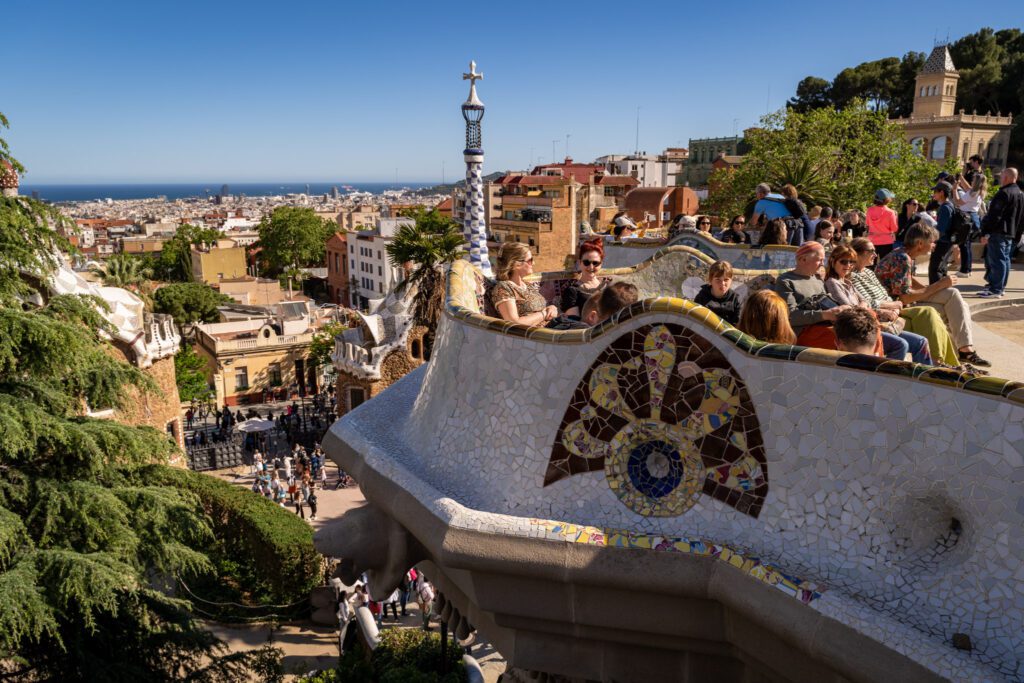
The main attraction of the day is absolutely Park Güell, a site that was built by Gaudí in the early 20th Century and has a very distinct modernist design and architecture that has led to it being declared a UNESCO World Heritage Site.
Despite having been to Park Güell before, it wasn’t until doing this Gaudí tour with Walks (my favorite tour company in Europe) on my latest trip that I realized that it wasn’t built to be a park, but an exclusive neighborhood for rich people (like a gated community) like the ones you found in England at the time.
However, it quickly became apparent that the concept wasn’t taking off here in Spain, so the project kind of fizzled out and, more recently, it became a park.
Regardless of its success as it was originally intended, it’s a cool place with interesting architecture (obviously, it’s Gaudí!).
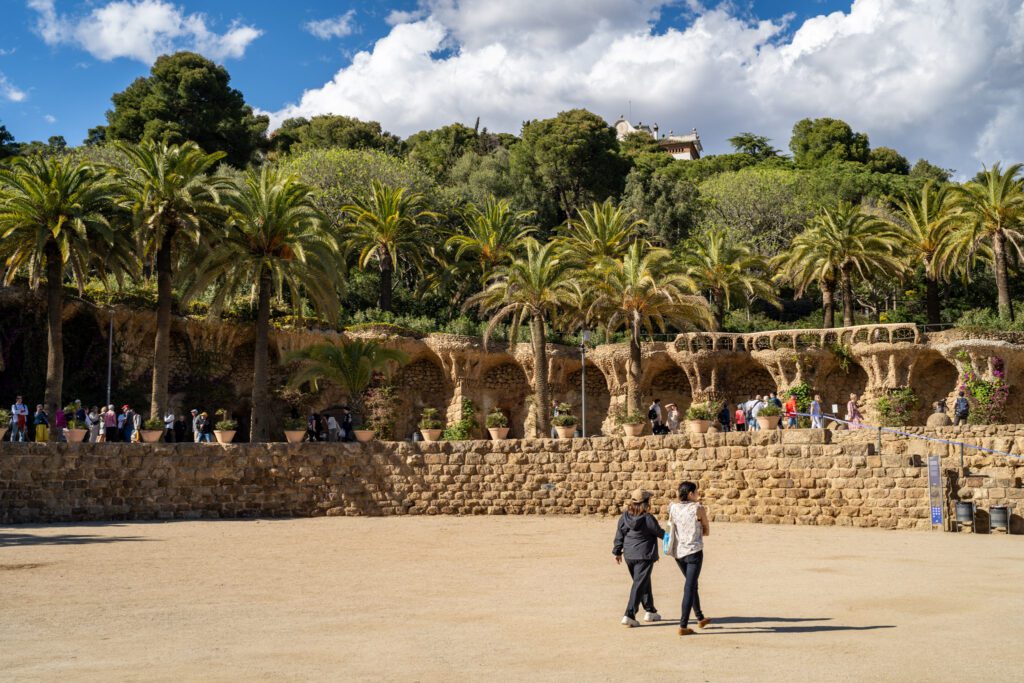
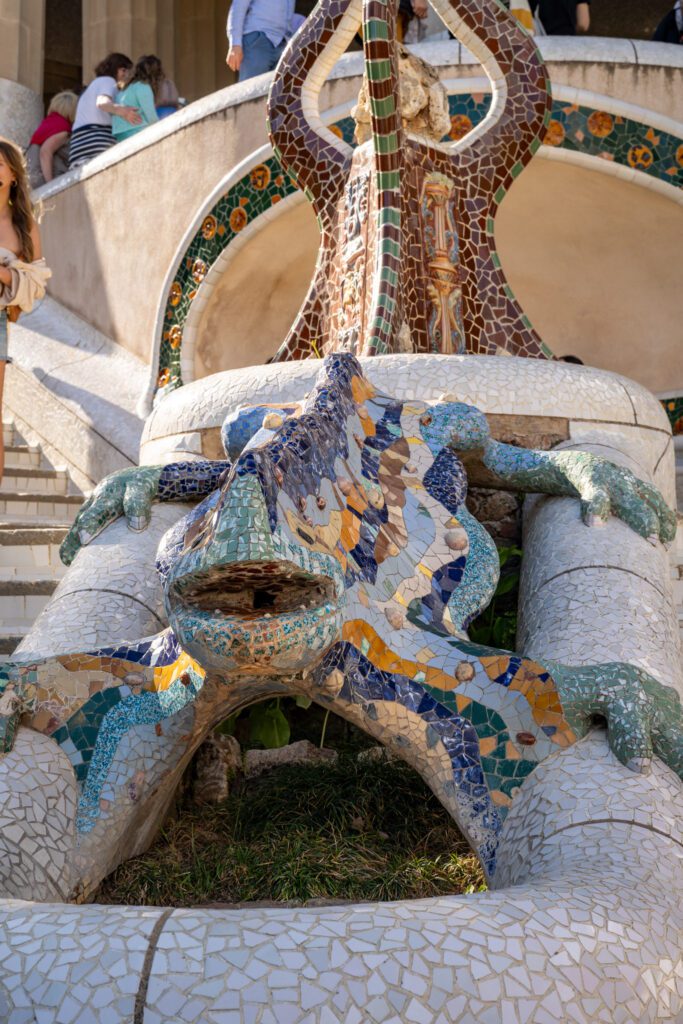
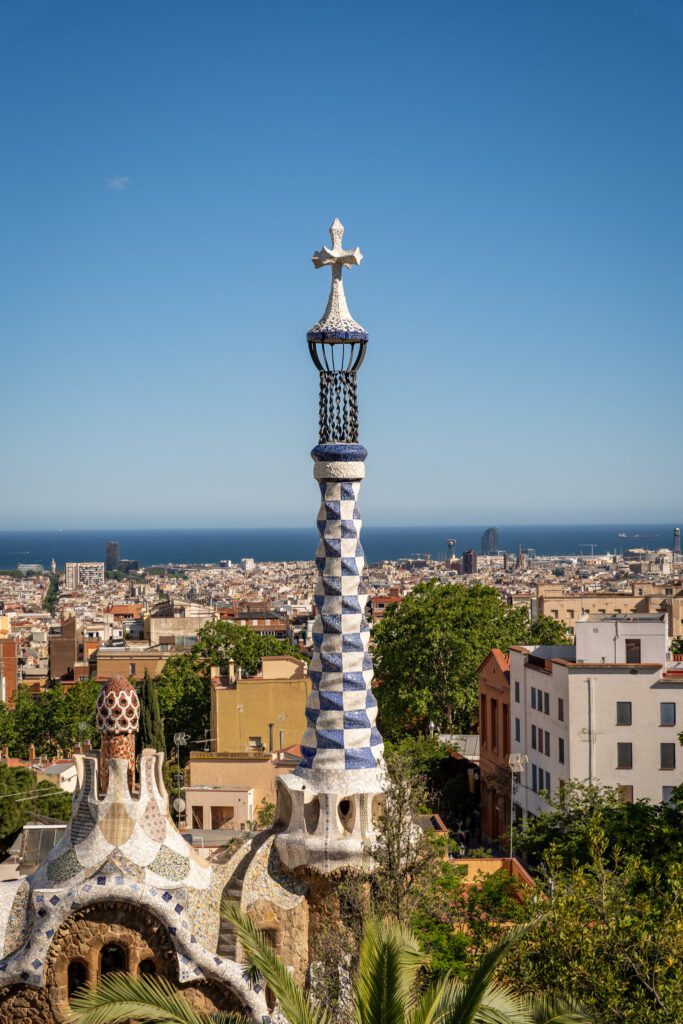
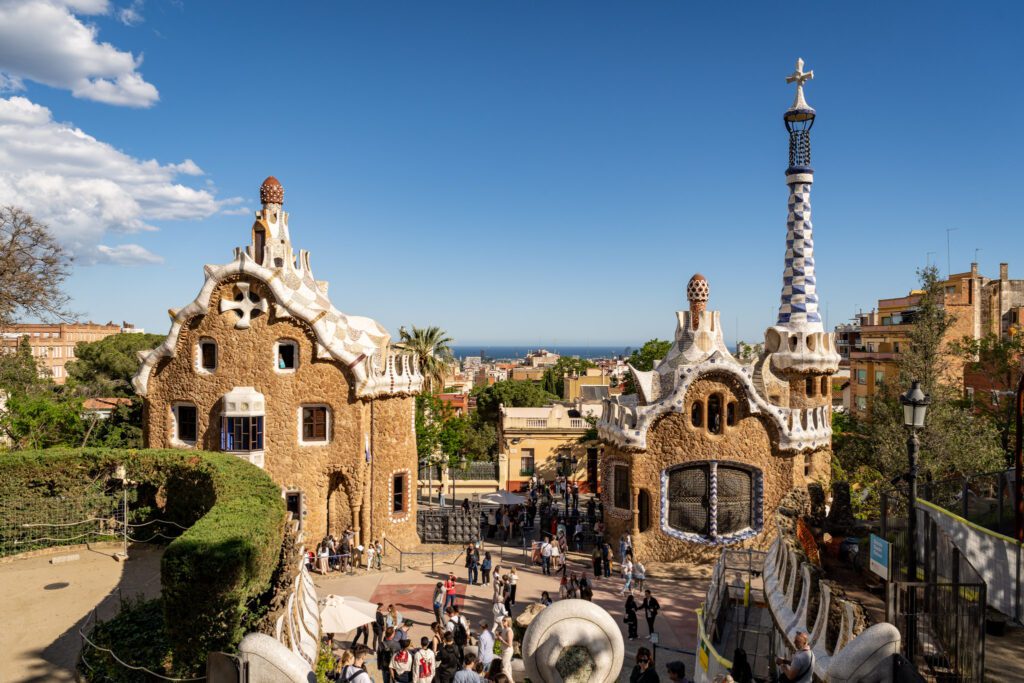
Our recommendation is to make sure to walk up the hill to the viewpoint at the top, which will take you away from the majority of the tourists (though there will definitely still be other people there).
Don’t miss the benches (really, one long bench), particularly the fact that it’s super comfortable despite being made of rock, and the drainage system for when it rains.
Oh, and the tile work – called trencadís – which refers to breaking the tile and reassembling it on a surface that isn’t flat.
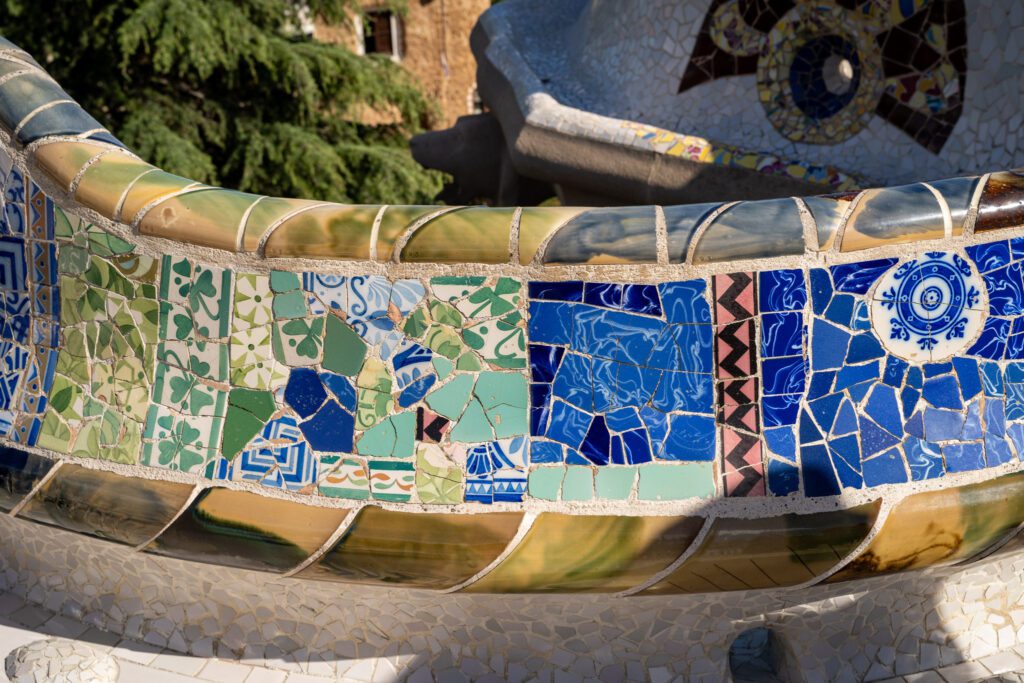
Getting Tickets for Park Güell
This place is not exactly off the beaten path. It’s usually packed with tourists from all over the world at all hours, which means you’re going to need to book tickets well in advance.
Basically, as soon as you know the dates for your Barcelona trip, see if there are tickets available.
This is the official site where you can buy tickets. There is an English version available, which makes it easier.
Like the Sagrada Familia, you’ll need to choose an exact entry time when you book your tickets. If you do the paella class beforehand, I’d do 4:00 pm to be safe.
I repeat: BUY TICKETS IN ADVANCE if you are coming in peak season. Trust us.
Tickets become available three months in advance. You can also buy skip the line tickets here.
An Evening in Gràcia
After a couple of hours at the park, head down into the neighborhood of Gràcia, which sprawls down the hill below the park. It’s our favorite area in Barcelona, and it has an impressive array of food and drinks and a more local vibe than most of the more central parts of Barcelona.
Never have I ever seen more dogs out for their morning and evening walks in Barcelona than in this part of town!
Here are some places that we think you should check out, though you really can’t go wrong just wandering the neighborhood, choosing a plaza and grabbing a table, and watching the world go by.
Las Vermudas is the place to go to learn about Spanish vermut, a fortified wine that you might know as “vermouth.”
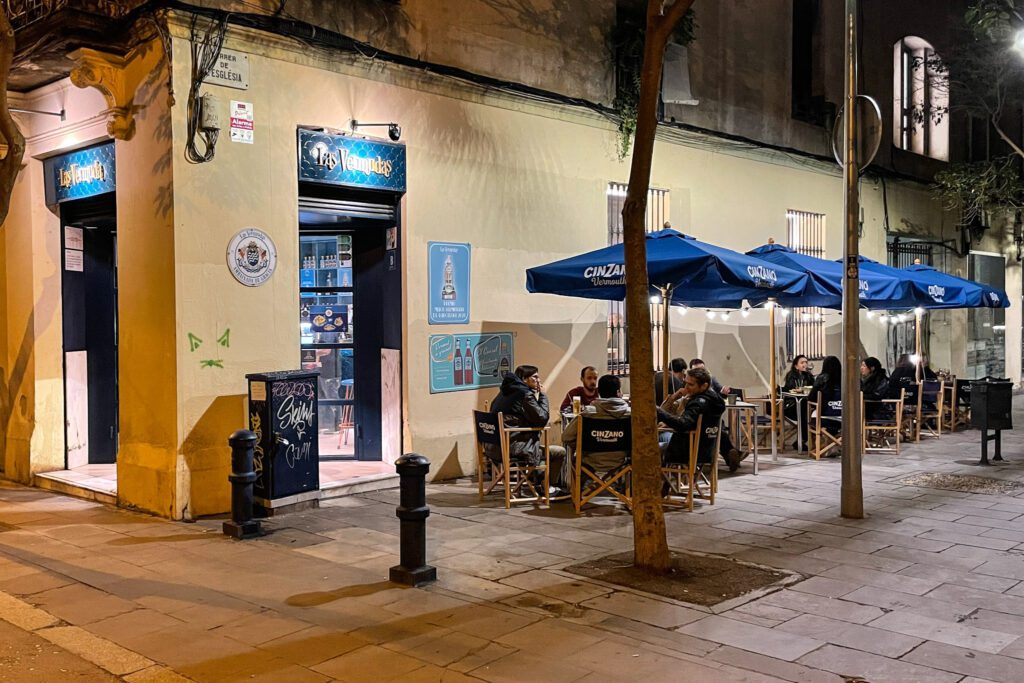
They won best Vermuteria in Barcelona in 2020, and we showed up on a weeknight and it was packed.
We knew exactly nothing about vermouth prior to coming here, and over the course of a couple of hours, the friendly servers and bartenders gave us a crash course in vermouth in Spain, which is sweeter and more aromatic than those from places like France and Italy (which are more common, at least in the US).
For great wine, head to Viblioteca, who has a nice array of wines to go with Spanish cured meats cheeses. Or to Bodega Bonavista, which is more of a wine store, but also does tastings and wines by the glass.
For Venezuelan arepas (and cachapas!) and cocktails, go to Rabipelao Gràcia.
The options in Gràcia are endless! You’ll see why we fell in love with this part of Barcelona as you’re walking down a well-lit street buzzing with a combination of locals and tourists mingling and starting their nights.
What to Do with More Time in Barcelona
If you’re lucky to have more time on your trip to Barcelona, here are a few ideas.
Add another day trip. Both Girona and Montserrat (and Tarragona) are worth your time, if you have it. You can use the section in the main itinerary above to plan the extra day trip.
Catch an F.C. Barcelona game. I, Matt, am a big soccer nerd, and going to an F.C. Barcelona game has been on my bucket list for years. Unfortunately, on this latest trip, they weren’t playing at Camp Nou (their main stadium) as it was being renovated, so I made the trek up the hill to Montjuïc to catch them playing there and got to see Robert Lewandowski score a hat trick in a thrilling 4-2 win over nearby Valencia. See their schedule and buy tickets here.
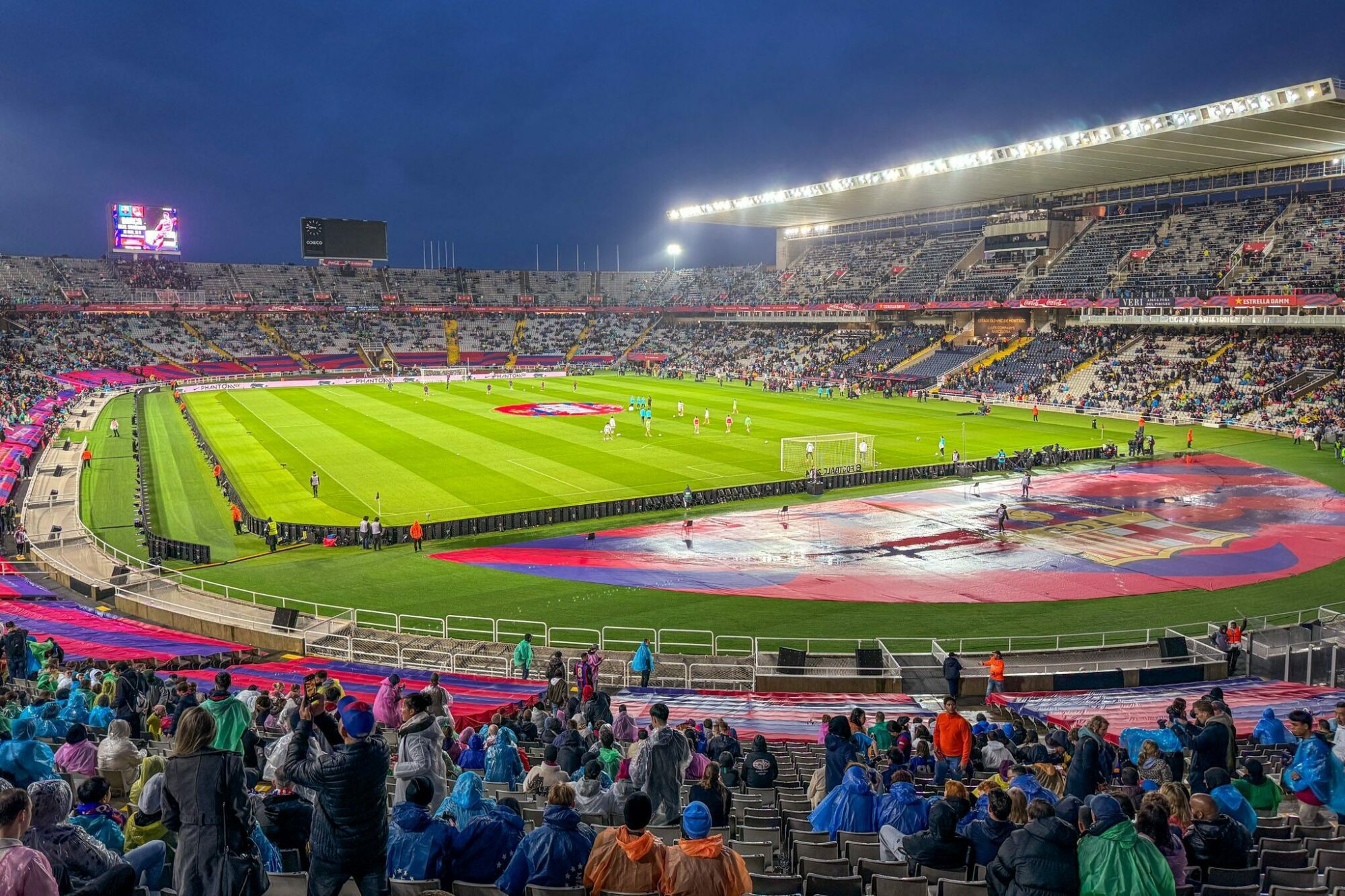
Explore Montjuïc. The hill that looms over Barcelona to the south (fun fact: the Sagrada Familia’s towers will be just lower than the highest point of Montjuïc because Gaudí believes in the power of God/nature, and didn’t want them to be higher than the highest natural point in the city). To get up there, you can either walk up through Poble-Sec at the foot of the hill on the south side, or enter from Plaça d’Espanya on the northern end and walk past the fountain and other developments built for the World Fair in 1929 that was held in Barcelona. Here’s the rough route that we’ve done before – don’t miss the viewpoints out over the Mediterranean along the southern edge of the mountain!
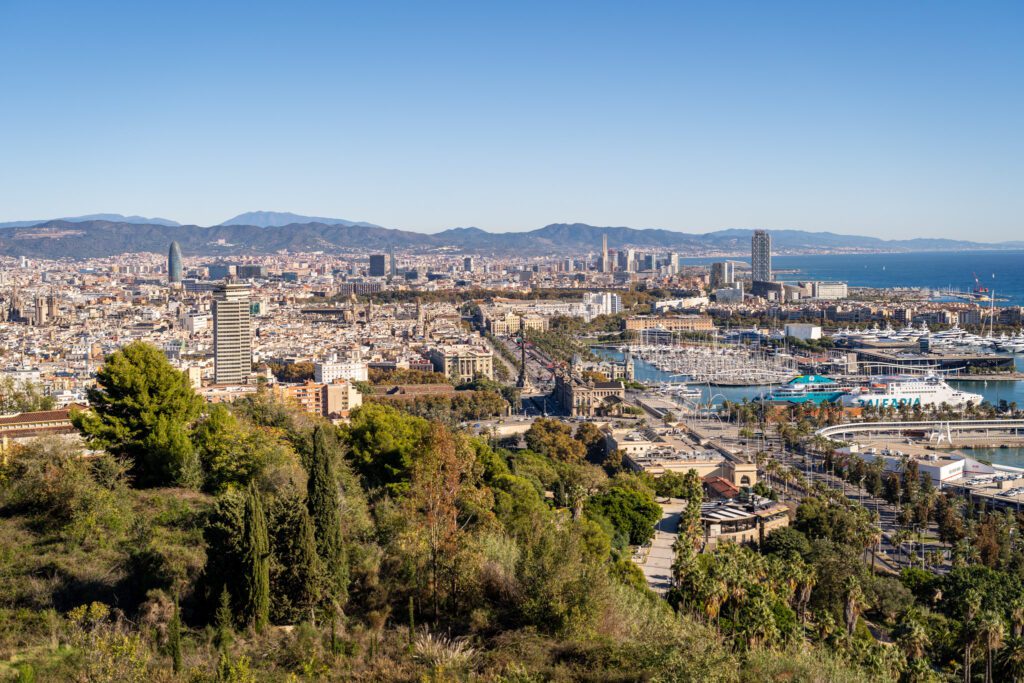
Hit another Gaudí site. We’d do Casa Batlló, which is right on Paseo de Gràcia and is probably the most impressive of his residential sites. But Casa Mila is just up the street, and is slightly less busy (only slightly, though). Whichever one you choose, get the audioguide to help you understand what you’re looking at and get the ever-important details about Gaudí’s thought process and details in the design.
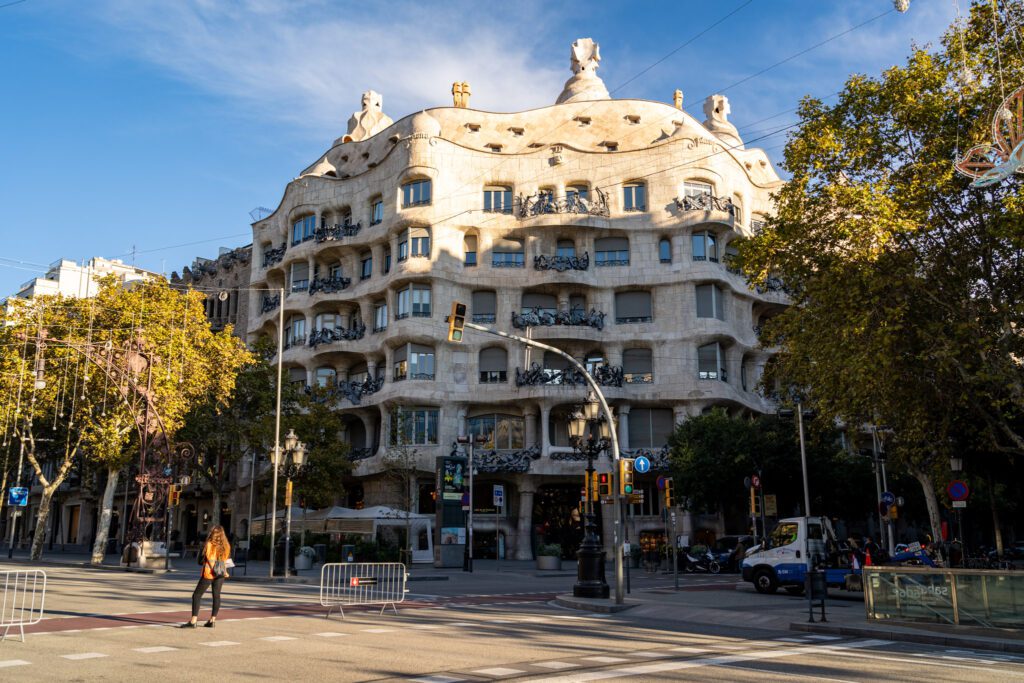
What to Do with Less Time in Barcelona
If you have less time in Barcelona, here’s how we’d organize your time to make the most of it. You won’t be able to see everything, but you can certainly see some of the highlights.
With Three Days
As much as we hate to say it, cut the day trip and follow the rest of the itinerary as written above.
We loved all of the day trips, but think it’s a better use of time to get deeper into Barcelona and the rich culture within its city limits. They can be saved for next time you make it to Catalonia!
With Two Days
With two days, we’d consolidate the itinerary above by doing a morning in the Gothic Quarter, the sights in Barceloneta, and either the Walking Tour OR the Food Tour on the first Day, then doing La Sagrada Familia, the Paella Class, and Park Guell on an action-packed second day.
With One Day
With only one day in Barcelona, you’re going to be really, really short on time. We’d do the Sagrada Familia first, which is our top sight to see in Barcelona, and then explore the Gothic Quarter with an evening Food Tour to round out the day.
Getting Around Barcelona
With limited time, we’d DEFINITELY recommend taking advantage of Barcelona’s wide-reaching and efficient metro system, which is one of the better ones in Europe.
Sure, you can absolutely walk around Barcelona since it’s flat until you get up towards Park Güell, but you’ll end up walking for 30 minutes to get between places on this itinerary.
It’s a beautiful city, don’t get us wrong, but we think you’ll appreciate the efficiency that comes with zipping around on the metro, covering that ground in eight minutes instead of 28.
The bus system is pretty good too, although the schedules posted weren’t quite accurate in our experience (which isn’t surprising, just something to note).
You can either buy tickets individually at 2.40 Euros a pop (which is expensive), as a group of 10 tickets (for one person) for 11.35 Euros, or you can get an Hola Card, which is their unlimited transport card for tourists, for 48-120 hours (in increments of 24 hours).
Tickets can be bought at the TMB (the metro system company) machines at most metro stations.
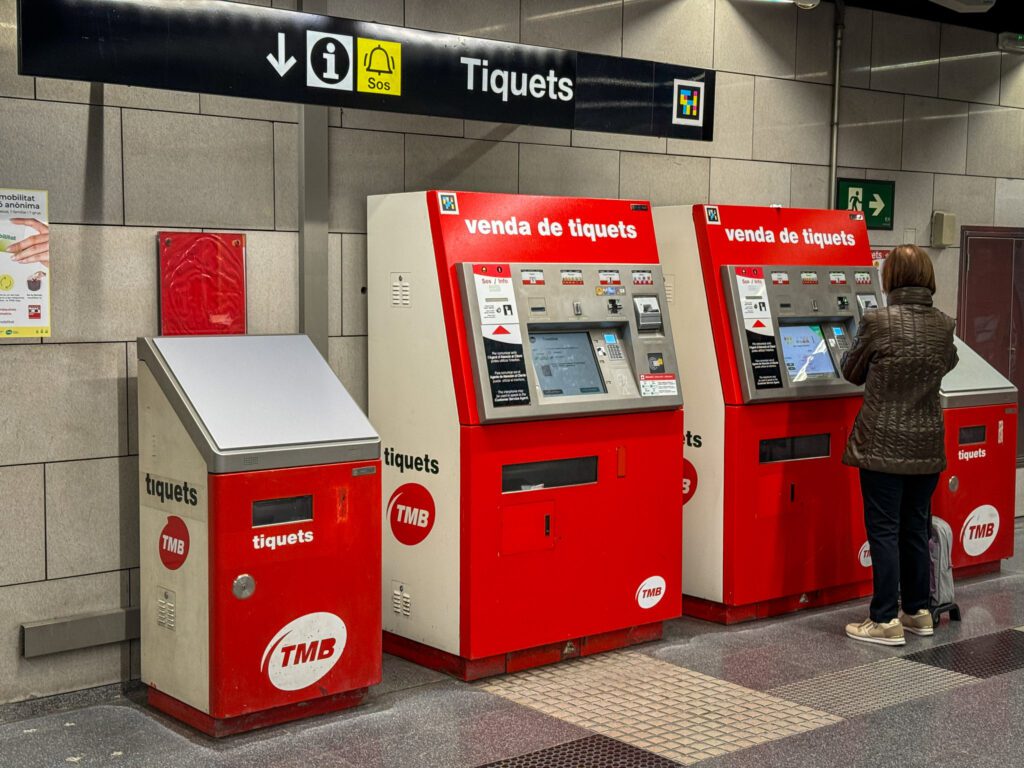
We went with the Hola Card (on both of our recent visits) and recommend that you do too, especially if you’re arriving in Barcelona via the airport, which is included in the price (and costs 5.15 Euros one-way).
You can get a discount if you buy it online in advance, and use a code to redeem it at the machines when you arrive.
Prices and ticket types might have changed, so make sure to check the official TMB website for the most up to date information.
Getting to Barcelona
If you’re planning a flight to Barcelona, there are a couple of important considerations to keep in mind before you book your trip.
Barcelona only has one main airport.
Budget airlines would have you believe that Girona Airport and Reus Airport are actually “Barcelona Girona” and “Barcelona Reus”.
In reality, these airports are around 75 miles (120km) away from Barcelona, on the outskirts of two completely separate cities.
It’s possible to find extremely cheap flights to these provincial airports, but much of the savings will be canceled out by the 1.5 hour trip to the center of Barcelona.
The Better Option: Fly into El Prat (BCN).
Barcelona’s real international airport is officially known as “Josep Tarradellas Barcelona-El Prat Airport”, or simply “El Prat” or “BCN”, for short.
The vast majority of long-haul international flights land here, and you can also connect to main European hubs like London, Frankfurt, and Paris.
How to Get into the City from the Airport
Once you’ve landed at El Prat, avoid an expensive taxi fare and take advantage of the excellent public transportation options into the city.
The best option is the metro – line L9 sud, which takes roughly 30 minutes (and departs every 7 minutes) costing 5.15 Euros each way.
It’s covered by the Hola Card, Barcelona’s unlimited public transit card for tourists, which you can buy in advance (for a 10% discount) and pick up at the departure station near Terminal 2.
Airport buses (Aerobús) run directly to the very central Plaça Catalunya every 15 minutes. The journey takes 40 minutes and only costs around 10 Euros for a return ticket (valid for 15 days) or 5.90 Euros for a one-way ticket, if this is a jumping-off point for a broader Spain itinerary.
IMPORTANT NOTE: This bus is NOT covered by the Hola Card!
Planning a trip to Spain? We’d love to help!
Here are our other Spain travel guides to help you plan an incredible trip (even if you have to eat gluten free!).
If there’s no link below, it means we’re still working on it – long, in-depth guides take time! We’re working on it, though, we promise.
The first place to start, if you haven’t already found them, is with our detailed itineraries. We have one shorter version for 7 days in Spain, one version that covers 10 days in Spain (a good middle ground, we think), and one longer version for two weeks in Spain (with ideas for more and less time in both guides).
Our Barcelona Guides
- What to do in Barcelona (as a First Timer)
- How to Plan an Amazing 4 Day Barcelona Itinerary
- Where to Stay in Barcelona: A Complete Guide for First Timers
- 12 Things to Know Before You Visit Barcelona
- Gluten Free Barcelona: A Complete Guide to GF Restaurants + Bakeries
- Where to Find the Best Specialty Coffee in Barcelona
- How to Plan an Incredible Day Trip to Montserrat (from Barcelona)
Our Madrid Guides
- What to do in Madrid (as a First Timer)
- How to Plan an Amazing Madrid Itinerary (2 Days)
- Where to Stay in Madrid: A Complete Guide for First Timers
- 12 Things to Know Before You Visit Madrid
- Gluten Free Madrid: A Complete Guide to GF Restaurants + Bakeries
- Where to Find the Best Specialty Coffee in Madrid (for Coffee Nerds)
- How to Plan an Amazing Day Trip to Toledo (from Madrid)
The Rest of Spain

Hi which hotels would you recommend for me and my 20 year son. It’s our first time visiting Spain and Barcelona. We are going to stay in Barcelona 5-6 days and i was thinking if we should break our stay in two places. Please give some good affordable/ boutique/ midrange hotel suggestions.
Hey there Necla! Exciting that you’ve got so much time in Barcelona! We have an entire guide dedicated to helping you figure out where to stay, including hotel recommendations. You can find that here:
https://wheatlesswanderlust.com/where-to-stay-barcelona-best-places/
Let us know if you have any specific questions and we’re more than happy to help.
Cheers,
Matt & Alysha